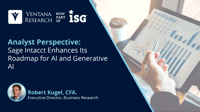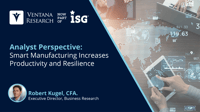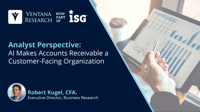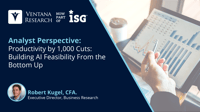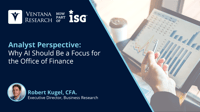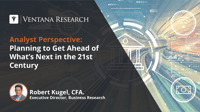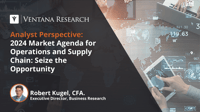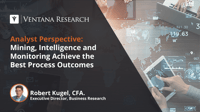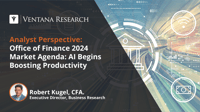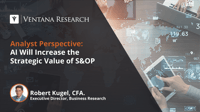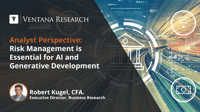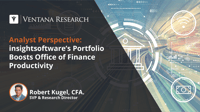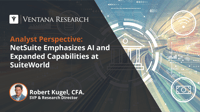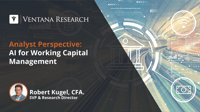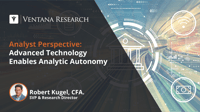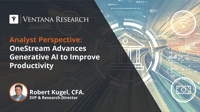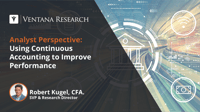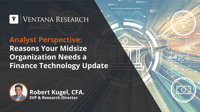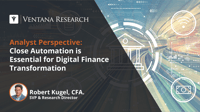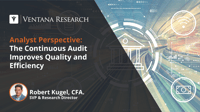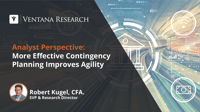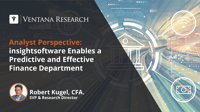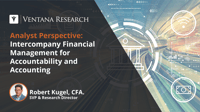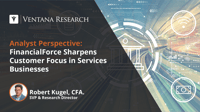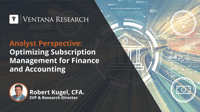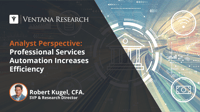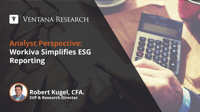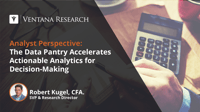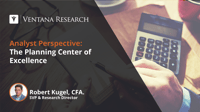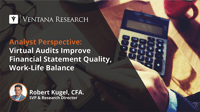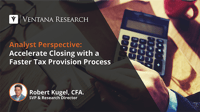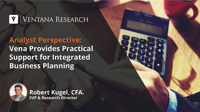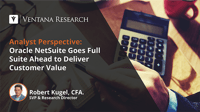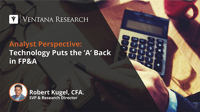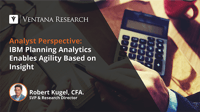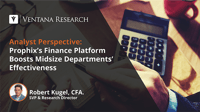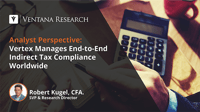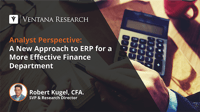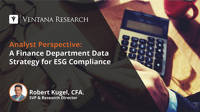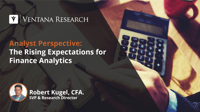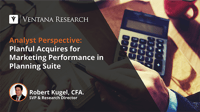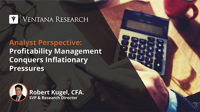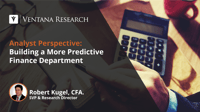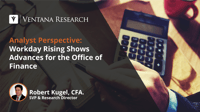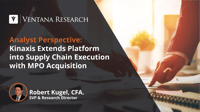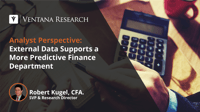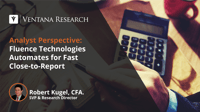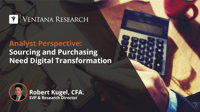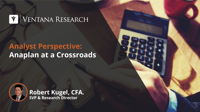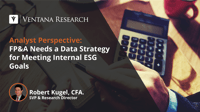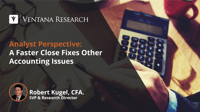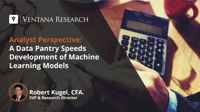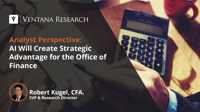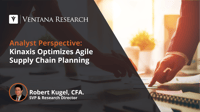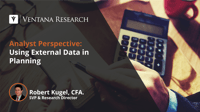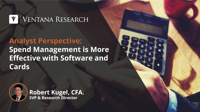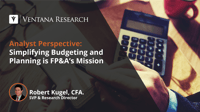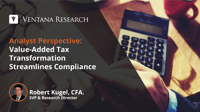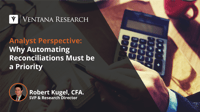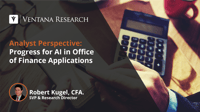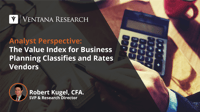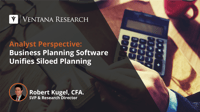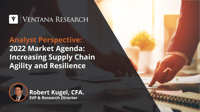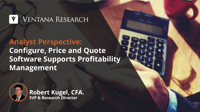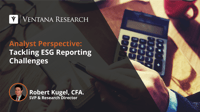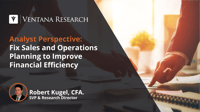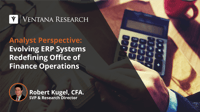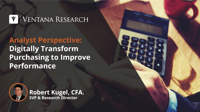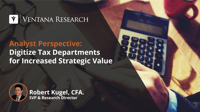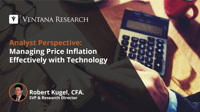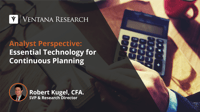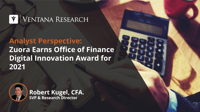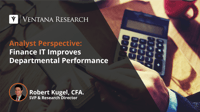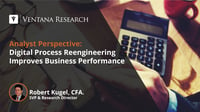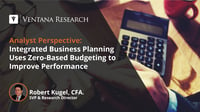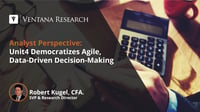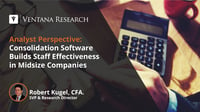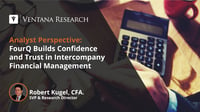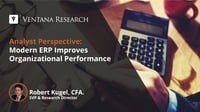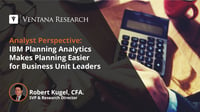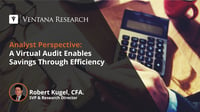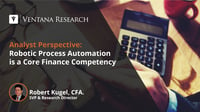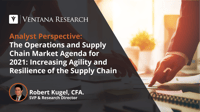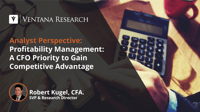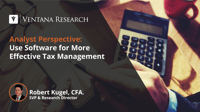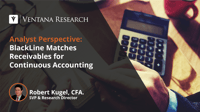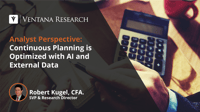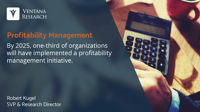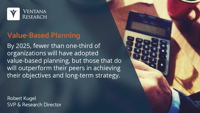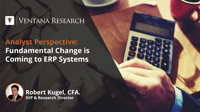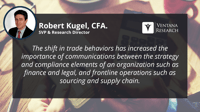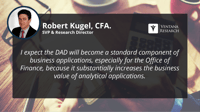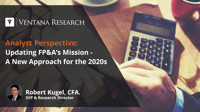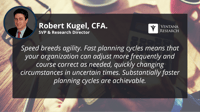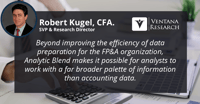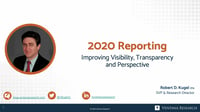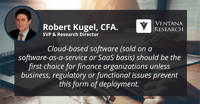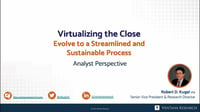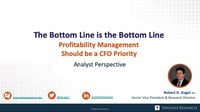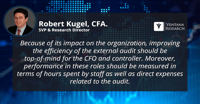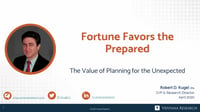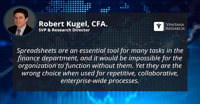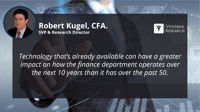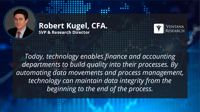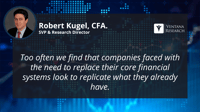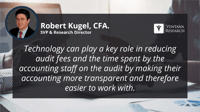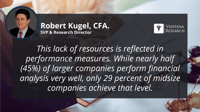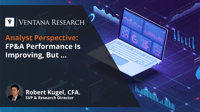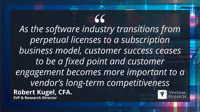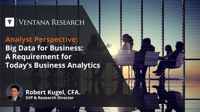Artificial intelligence-enabled business applications have advanced considerably over the past year as software providers have added a steady stream of capabilities. This includes customer facing, financial, supply chain and workforce software. ISG Research asserts that by 2027, almost all providers of business applications will use some form of generative AI to enhance capabilities and functionality to remain competitive.
Read More
Topics:
Office of Finance,
Business Planning,
ERP and Continuous Accounting,
digital finance,
Revenue, Lease and Tax Accounting,
Purchasing/Sourcing/Payments,
Consolidate/Close/Report,
AI and Machine Learning
Prophix launched its Prophix One platform earlier this year. CFOs of midsize enterprises should take a look at it because it supports a more effective approach to finance and accounting operations in growing companies. It facilitates the transition of organizations that can no longer make do with work-arounds of existing systems to those with formal, controlled core processes that can be completed faster with reduced risk. The platform performs financial consolidation, account reconciliation...
Read More
Topics:
Office of Finance,
Business Planning,
ERP and Continuous Accounting,
digital finance,
AI and Machine Learning,
Consolidate and Close Management
Sage recently held an analyst summit to take a deeper dive into its product and technology roadmap, complementing sessions it held at its 2024 user group conference that I commented on earlier this year. ERP systems have been central to the operational and financial management of enterprises since they first appeared in the 1990s. They are so familiar that they have become part of the background and only noticeable when something fails. We are now in a major transition to a new era of...
Read More
Topics:
Office of Finance,
ERP and Continuous Accounting
ERP systems have been the central nervous system of enterprises for more than three decades, handling business-critical process management and recordkeeping. While their basic outlines are unchanged, today’s systems are far more capable in their functional depth, adaptability, usability and manageability. Especially for cloud-based systems, they are far easier to maintain. Decades of refinement and focused development to support specific industries, and even specialized categories within these...
Read More
Topics:
Office of Finance,
ERP and Continuous Accounting,
digital finance,
Generative AI,
Procure-to-Pay,
Order-to-Cash
OneStream offers a platform designed to serve the needs of accounting and financial planning and analysis (FP&A) organizations. The software handles financial close and consolidation, planning and budgeting, analysis and reporting. OneStream recently held its annual user conference, Splash, in Las Vegas. In attending this meeting, my focus was on progress the company has made in the areas of predictive artificial intelligence (AI) and generative AI (GenAI) over the past year, since the...
Read More
Topics:
Office of Finance,
Business Planning,
ERP and Continuous Accounting,
digital finance,
AI and Machine Learning,
Financial Consolidation and Close Management
Improving data management is at the forefront of my Office of Finance research practice because, when not managed well, it can have a profoundly negative impact on departmental efficiency, individual performance, organizational agility and sustainability. Conversely, straight-through processing (STP), a business process design and data management methodology, reduces process friction throughout an organization and, by minimizing errors, builds trust in the accuracy and reliability of all data,...
Read More
Topics:
Office of Finance,
ERP and Continuous Accounting,
digital finance,
Procure-to-Pay,
Order-to-Cash
At this stage of the development of Generative AI, there’s much we can see clearly (at least we think we can), but there’s even more likely to surprise us. As that great 20th-century philosopher and hall-of-fame catcher, Yogi Berra, famously said, “It’s tough to make predictions, especially about the future.” The breadth and speed of innovation today in all aspects of GenAI rivals that of the internet in the 1990s, and for the same reason.
Read More
Topics:
ERP and Continuous Accounting,
digital finance,
Generative AI,
Model Building and Large Language Models,
Procure-to-Pay,
Order-to-Cash
I am happy to share insights gleaned from our latest Buyers Guide, an assessment of how well software providers’ offerings meet buyers’ requirements. The Financial Consolidation and Close: ISG and Ventana Research Buyers Guide is the distillation of a year of market and product research by ISG and Ventana Research.
Read More
Topics:
Office of Finance,
Consolidate and Close Management
Until recently, dedicated consolidation software had been a sleepy category. First introduced in the 1980s as a tool designed to run on personal computers (freeing the accounting department from reliance on its IT department), offerings basically achieved feature and function parity by the next decade. The last major technology innovation—moving the software to the cloud—began in the mid-2000s. Cloud-based software reduces the cost and complexity of ownership, making dedicated software a more...
Read More
Topics:
Office of Finance,
ERP and Continuous Accounting,
digital finance,
Generative AI,
Consolidate and Close Management
Rebalancing supply chains to improve resiliency has been a focus of enterprises with even moderately complex and long supply chains for the past four years. One aspect of this rebalancing is that it almost always involves higher costs. Volume discounts and bargaining power are reduced when more suppliers are used, or an alternate supplier may have higher factor costs and therefore must charge more. Logistics costs might increase, and when an enterprise moves from just-in-time to just-in-case...
Read More
Topics:
Continuous Planning,
Business Planning,
Operations & Supply Chain,
Continuous Supply Chain & ERP
Oracle held an industry analyst summit recently where the focus was on artificial intelligence (AI) and embedded AI. At the event, Oracle demonstrated progress in adding useful AI-enabled capabilities to its business applications, especially in finance and accounting, supply chain, HR and revenue management. To put this into context, across the software industry, AI is already at work in many finance-focused applications that are currently available, albeit often in limited release. We are in...
Read More
Topics:
Office of Finance,
Analytics,
Business Planning,
ERP and Continuous Accounting,
AI,
digital finance,
Generative AI,
AI and Machine Learning,
Procure-to-Pay,
Order-to-Cash,
Consolidate and Close Management
Value-added tax is a consumption tax levied at every point in a supply chain—from production to final sale. It’s based on the difference between the cost of production and the selling price of a product or service, or the value added. Sales taxes are different in that they are generally collected only at the final point of sale to the ultimate consumer. Enterprises collect the value-added tax from customers when they sell goods or services and remit the collected VAT to the relevant national or...
Read More
Topics:
Office of Finance,
Tax,
tax compliance,
digital finance,
Order-to-Cash,
Value-Added Tax,
Sales Tax
We’re quickly approaching the moment when it becomes clear that artificial intelligence (AI) and generative AI (GenAI) will not be free. As that happens, we will discover who’s willing to pay how much and for what. After nearly 18 months of unlimited use-case fantasizing, it should be obvious that not all the potential applications of AI can be realized over the next three to five years because they fail a cost/benefit test. In theory, AI’s potential is almost limitless, but so far, little...
Read More
Topics:
Office of Finance,
Analytics,
Business Planning,
ERP and Continuous Accounting,
AI,
digital finance,
Procure-to-Pay,
Order-to-Cash,
Consolidate and Close Management
The tax provision process is an essential part of the close process and a core responsibility of tax departments. This process estimates the amount of income tax an enterprise will have to pay tax authorities in the jurisdictions in which it operates. Tax accountants derive the number by adjusting the reported net income with a variety of permanent differences, such as expenses that are not deductible and temporary differences–for example, using allowable accelerated depreciation for tax...
Read More
Topics:
Office of Finance,
ERP and Continuous Accounting,
digital finance
If you search “for want of a nail” on your browser, you’ll discover the age-old wisdom that seemingly trivial things can have a far-reaching impact. It’s a parable for artificial intelligence used in business. Deconstruct the imagined big-picture impact of AI and there are thousands of minor tasks that soon will require little or no human involvement in the interstices of an end-to-end process. Humans will still be indispensable, but they won’t be doing predictably repetitive work....
Read More
Topics:
Office of Finance,
Order-to-Cash
There have been a multitude of potential use cases for artificial intelligence (AI) and generative AI (GenAI) dreamed up over the past 18 months. ISG-Ventana Research describes AI as the development of systems and software capable of automating tasks that have previously required human intelligence. It encompasses machine learning (ML), deep learning and GenAI to deliver capabilities including predictions, recommendations, personalization, speech and visual recognition as well as translation...
Read More
Topics:
Office of Finance,
digital finance,
Procure-to-Pay
Sage Intacct recently held its annual user conference, and while there were plenty of product announcements and roadmap presentations, my focus here is on the artificial intelligence elements. AI–both predictive and generative–is the most important capability and differentiator in software aimed at finance and accounting departments. Ventana Research asserts that by 2027, almost all vendors of ERP software will incorporate AI to reduce workloads, speed processes and decrease errors.
Read More
Topics:
Office of Finance,
Business Planning,
ERP and Continuous Accounting,
digital finance,
Purchasing/Sourcing/Payments,
Consolidate/Close/Report
Smart manufacturing is a strategic operating approach that aligns advanced manufacturing technology with system and process design principles to promote adaptability. It is a digital, event-driven, collaborative orchestration of physical and digital processes designed to increase productivity, efficiency, adaptability and resilience. These systems use technologies to coordinate the planning and execution of even disparate operations within factories and across an entire manufacturing supply...
Read More
Topics:
Continuous Planning,
S&OP,
Operations & Supply Chain,
supply chain management,
Manufacturing,
Continuous Supply Chain & ERP,
Smart Manufacturing
Artificial intelligence seems poised to change everything, although naturally a great deal of attention tends to be paid to the cool things it makes possible. AI can also make the humdrum less tedious and even transform the dullest of back-office operations into something more meaningful. For example, AI can take accounts receivable automation to the next level.
Read More
Topics:
Office of Finance,
AI,
digital finance,
AI and Machine Learning,
Order-to-Cash
Zoho recently held its annual analyst day to communicate its strategy, objectives and product roadmap. The privately held company, headquartered in Chennai, Tamil Nadu, India, has an unconventional approach to the software market. Its self-described corporate philosophy emphasizes making bold moves that challenge assumptions. Its design engineering approach stresses simplicity and cost while aiming to provide easy-to-use software with sufficient capabilities to improve personal and...
Read More
Topics:
Office of Finance,
Voice of the Customer,
Digital Commerce,
ERP and Continuous Accounting,
digital finance,
Customer Experience Management,
Generative AI,
Procure-to-Pay,
Order-to-Cash
After a year of near-constant AI chatter, the broad strokes of how the technology will roll out in business over the next three to five years are coming into place. It’s almost trite but worth repeating that artificial intelligence will drive a substantial boost in productivity as it’s adopted. Rather than making large swathes of jobs obsolete, it will take the robotic work out of those job descriptions, enabling people to focus on tasks with a greater economic return.
Read More
Topics:
Office of Finance,
Business Planning,
ERP and Continuous Accounting,
AI,
digital finance,
Generative AI,
Procure-to-Pay,
Order-to-Cash,
Consolidate and Close Management
With a year of AI-everywhere-all-the-time chatter now in the rearview mirror, finance and accounting department executives appear to be in a state of apprehension and well-tuned skepticism about the impact this technology will have on their organization. There are solid reasons to believe that the next few years will be transformative, making it important for departments to adopt a fast-follower approach to artificial intelligence. Rather than being a laggard, leaders must be ready to take...
Read More
Topics:
Office of Finance,
Business Planning,
ERP and Continuous Accounting,
digital finance,
Procure-to-Pay,
Order-to-Cash,
Consolidate and Close Management
We live in an era of uncertainty, not unpredictability. Managing in uncertain times is always difficult, but tools are available to improve the odds for success by making it easier and faster to plan for contingencies and scenarios. Software makes it possible to manage ahead of any future event, connecting the tactical trees to the strategic forest. The purpose of planning is not just to create a plan: Enterprises spend time thinking ahead because it enables leadership teams, executives and...
Read More
Topics:
Office of Finance,
Continuous Planning,
Data Management,
Business Planning,
data operations,
digital finance,
AI and Machine Learning
Digitally transforming finance operations has been a priority since 2020. For purchasing and the procure-to-pay cycle, software can streamline processes, shorten process times, reduce unnecessary costs, provide greater visibility into cash flows, increase control and improve results. Digitizing operations helps attract and retain the best talent because professionals spend less time on mechanical, repetitive tasks. For all these reasons, beginning this year, Ventana Research’s Office of Finance...
Read More
Topics:
Office of Finance,
Continuous Planning,
Business Planning,
digital finance,
supplier relationship management,
Continuous Supply Chain & ERP,
Generative AI,
Procure-to-Pay
Ventana Research recently announced its 2024 market agenda for Operations and Supply Chain, continuing the guidance we have offered for more than two decades to help enterprises across industries derive optimal value and improved outcomes from business technology.
Read More
Topics:
Continuous Planning,
Product Information Management,
Operations & Supply Chain,
Sustainability Management,
supplier relationship management,
Property Technology,
Continuous Supply Chain & ERP
Since a majority of today’s workforce wasn’t around in the 1990s, it’s worth noting that “business process reengineering” was all the rage. The purpose was to review, restructure and redesign core business processes to achieve substantial improvements in market and customer responsiveness, productivity, cycle times and quality. One reason for its popularity (beyond being a money spinner for consultants) was the promised ability for the newly available enterprise resource planning systems to be...
Read More
Topics:
Operations & Supply Chain,
Enterprise Resource Planning,
ERP and Continuous Accounting,
digital finance,
Purchasing/Sourcing/Payments,
Continuous Supply Chain & ERP
Ventana Research recently announced its 2024 Market Agenda for the Office of Finance, continuing the guidance we have provided since 2004 on the practical use of technology for the finance and accounting department. Our insights and best practices aim to enable enterprises to operate with agility and resiliency, improving performance and delivering greater value as a strategic partner.
Read More
Topics:
Office of Finance,
Business Planning,
ERP and Continuous Accounting,
digital finance,
Consolidate/Close/Report
Sales and operations planning (S&OP) is trending toward becoming more strategic in product-centric companies through the end of the decade. The purpose of S&OP has grown in importance. Since the mid-teens, the trade and economic environment has become less benign and more unpredictable, forcing many enterprises to redesign their supply chains for resiliency while still surmounting the dual challenges of remaining cost competitive and achieving financial targets. Over the past decade, there have...
Read More
Topics:
Continuous Planning,
Operations & Supply Chain,
Enterprise Resource Planning,
digital finance,
Sustainability Management,
AI and Machine Learning
The recent launch of the AI Alliance, a coalition of more than 50 corporations and research institutions engaged in artificial intelligence (AI) development (including AMD, CERN, Cornell University, Dell Technologies, IBM, Intel, Linux Foundation, Meta, NASA, Oracle, ServiceNow and Sony Group), aims to achieve the following objectives:
Read More
Topics:
Office of Finance,
Business Planning,
Enterprise Resource Planning,
ERP and Continuous Accounting,
digital finance,
Revenue, Lease and Tax Accounting,
Purchasing/Sourcing/Payments,
Consolidate/Close/Report,
Continuous Supply Chain & ERP
Billtrust software manages the full accounts receivable (A/R) cycle, from invoicing to payments, to increase the productivity of the A/R staff while providing customers with a better experience and reducing frictions in their order-to-pay motions. The company’s unified A/R software supports credit application automation, invoice delivery, collections, cash application, payment management and a business payments network (BPN).
Read More
Topics:
Office of Finance,
digital finance,
Purchasing/Sourcing/Payments
Doing more by doing less means using artificial intelligence and related technologies to make financial planning and analysis organizations more productive. By eliminating low-value and unproductive work, AI enables FP&A teams to free up considerable time for more useful and consequential forecasting, planning, budgeting, analysis and reporting.
Read More
Topics:
Office of Finance,
Continuous Planning,
Business Planning,
digital finance
We conducted our recent Smart Financial Close Dynamic Insights Research in part to assess to what extent the substantial disruptions of the pandemic have impacted the accounting close. When office lockdowns began in the first quarter of 2020, many finance departments were challenged to conduct the quarterly close remotely without face-to-face interactions. In the United States, the Securities and Exchange Commission was so concerned that corporations would be unable to meet filing deadlines...
Read More
Topics:
Office of Finance,
Financial Performance Management,
ERP and Continuous Accounting,
digital finance,
Smart Financial Close
insightsoftware offers a portfolio of software designed mainly for the office of finance to handle reporting, budgeting and planning, consolidation and close management, business intelligence (BI) and analytics, as well as compliance. The company’s applications directly address a core issue confronting many finance department executives today: Productivity. The U.S. Bureau of Labor statistics reported that 17% of accountants retired or resigned in the 2020-22 period, cutting the available...
Read More
Topics:
Office of Finance,
Business Planning,
ERP and Continuous Accounting,
digital finance,
Analytic Data Platforms,
Revenue, Lease and Tax Accounting,
Consolidate/Close/Report
Board offers a platform that enables financial planning and analysis (FP&A) groups to forecast, plan, budget, analyze and report, using a consistent set of data from across the business to speed these processes, improve forecast and planning accuracy, and accelerate analysis and reporting. Board was categorized as an Exemplary Vendor in our Ventana Research Business Planning Value Index, with leading in Manageability and Reliability.
Read More
Topics:
Office of Finance,
Continuous Planning,
Business Planning,
Operations & Supply Chain,
Enterprise Resource Planning,
digital finance
The emphasis on environmental, social and governance (ESG) issues has been growing for some time. I participated in the development of the Sustainability Accounting Standards Board (SASB) as a software industry expert more than a decade ago. The rise of ESG’s profile in corporate reporting is the latest evolution of “responsible investing,” a topic that goes back centuries in the west. The modern era of responsible investing took form in the United States beginning in the 1960s and then...
Read More
Topics:
Governance,
Office of Finance,
Business Planning,
ERP and Continuous Accounting,
digital finance,
ESG,
Environmental
SuiteWorld, the annual user conference from Oracle NetSuite, focused on three topics: artificial intelligence, a reimagination of the role NetSuite can play in managing an organization and emphasizing the value to existing customers of using more of what NetSuite has to offer.
Read More
Topics:
Office of Finance,
Business Planning,
ERP and Continuous Accounting,
digital finance,
Consolidate/Close/Report
Because artificial intelligence is top-of-mind, Workday spent a great deal of time on the topic at its recent Workday Rising annual user group meeting in San Francisco. It was front and center in the general sessions, in the announcements made at the event and in the product roadmaps.
Read More
Topics:
Office of Finance,
Business Planning,
ERP and Continuous Accounting,
digital finance,
Purchasing/Sourcing/Payments,
AI and Machine Learning
I am happy to share insights gleaned from our latest Buyers Guide, an assessment of how well vendors’ offerings meet buyers’ requirements. The Ventana Research 2023 Business Planning Buyers Guide is the distillation of a year of market and product research by Ventana Research. Drawing on our Benchmark Research, we apply a structured methodology built on evaluation categories that reflect the real-world criteria incorporated in a request for proposal to Office of Finance vendors supporting the...
Read More
Topics:
Office of Finance,
Business Planning
The 2023 Ventana Research Buyers Guide for Business Planning research enables me to provide observations about how the market has advanced.
Read More
Topics:
Office of Finance,
Business Planning
In accounting terms, working capital includes current assets (short-term items such as cash, money due from customers and inventory) and current liabilities (typically payments due to suppliers and loan amounts that must be repaid within one year). Working capital management is a prime function of the finance organization, designed to balance often-conflicting objectives related to revenue, liquidity, risk and profitability. The basics of working capital management date back to ancient clay...
Read More
Topics:
Office of Finance,
CFO,
ERP and Continuous Accounting,
digital finance,
Purchasing/Sourcing/Payments,
Accounts Payable,
Treasury,
Accounts Receivable,
Working Capital
This title plays on the now-ancient meme from the 1990s: “On the internet, nobody knows you’re a dog,” which pointed to a challenge of anonymity posed by new technology. In this case, though, I’m using it to highlight an opportunity that generative artificial intelligence presents in streamlining routine business functions that require some level of individual skill and experience to handle. Ordinary contracts are just one example of work products that require humans to create, edit, analyze,...
Read More
Topics:
Office of Finance,
Digital Technology,
digital finance,
AI & Machine Learning,
robotic automation,
Generative AI
Over the past three years, the Public Company Accounting Oversight Board (or PCAOB, sometimes pronounced “peekaboo”) has found an increasing prevalence of auditing deficiencies in its inspections of accounting firms. PCAOB was established as part of the Sarbanes-Oxley Act of 2002 in the wake of several major accounting scandals. The agency acts as the auditor of auditors with the objective of being a neutral arbiter of the quality of these inspections. It recently indicated that approximately...
Read More
Topics:
Office of Finance,
audit,
ERP and Continuous Accounting,
digital finance,
virtual audit,
Consolidate/Close/Report
A century ago, the big breakthrough in telephones was the ability to dial your party’s number directly. Dialing became necessary when enough people had telephones to require a shift from people-assisted to fully automated connections. But direct dialing was only a local option – you still needed an operator to make long-distance calls. In the 1920s, commenting on their forecast for the expected growth of long-distance calling, the analysts at Bell Laboratories concluded that by midcentury, the...
Read More
Topics:
Office of Finance,
Analytics,
Business Planning,
AI & Machine Learning
We added purchasing, sourcing and payments to our core Office of Finance focus areas this year to reflect new and important opportunities to use technology to gain effectiveness through greater efficiency. Technology continues to lubricate the wheels of commerce, aided by a financial services sector that is constantly innovating, responding to market-driven opportunities to reduce costs, increase demand or lower risk. Ventana Research asserts that, in many cases, technology makes new forms or...
Read More
Topics:
Operations & Supply Chain,
Enterprise Resource Planning,
ERP and Continuous Accounting,
digital finance,
Purchasing/Sourcing/Payments,
Continuous Supply Chain & ERP
The six costliest words in managing a finance department are, “we’ve always done it this way.” Closing the books is the process of finalizing and summarizing the financial activities of a business for a specific accounting period (typically a month, quarter, or fiscal year). It involves completing various tasks to ensure that all revenue, expense, and other financial transactions are properly recorded, accounts are balanced, and financial statements are prepared. Accounting processes are...
Read More
Topics:
Office of Finance,
ERP and Continuous Accounting,
digital finance,
AI & Machine Learning,
Revenue, Lease and Tax Accounting,
Consolidate/Close/Report
As we celebrate the first half of what seems to be the year of generative artificial intelligence, with an apparently unlimited discussion of use cases and bogeymen, my attention is turning to the very mundane question of costs. Specifically, how costs incurred – through investment and operation – will be distributed along the value chain and how this will affect the demand for AI ‒ by whom and for what purpose. It’s a question that needs asking even though, at this stage in the market’s...
Read More
Topics:
Office of Finance,
Continuous Planning,
Business Planning,
Enterprise Resource Planning,
natural language processing,
digital finance,
AI & Machine Learning,
Consolidate/Close/Report,
Continuous Supply Chain & ERP
I recently attended Sage Software’s Partner Summit. Implementation partners account for most of the sales and implementation of finance and accounting applications designed for small and midsize businesses, so they are important to the success of the software vendor. These events are designed to inform partners of product enhancements and the product and technology roadmap as well as provide a perspective on market conditions and trends.
Read More
Topics:
Office of Finance,
Business Planning,
ERP and Continuous Accounting,
digital finance,
AI & Machine Learning,
Purchasing/Sourcing/Payments,
Consolidate/Close/Report
Organizations engage in collaborative supply chain planning in order to have more accurate, timely and actionable information, including forecasts and stock-on-hand. The objective is to achieve lower costs and reduce risk while ensuring order fulfillment to achieve optimal supplier and customer relationships. Unfortunately, our research shows that that few companies manage collaboration well in their sales and operations planning (S&OP) processes. Today, S&OP software has become more accessible...
Read More
Topics:
Operations & Supply Chain,
Enterprise Resource Planning,
Continuous Supply Chain & ERP
Planful, a financial planning and consolidation software vendor, held its annual Perform23 user conference in May. The event showcased the company’s ongoing investments to provide finance and accounting departments with the means to improve effectiveness by enhancing efficiency.
Read More
Topics:
Office of Finance,
Business Planning
The Office of Finance can be compared to a numbers factory where the main raw material, data, is transformed into financial statements, management accounting, analyses, forecasts, budgets, regulatory filings, tax returns and all kinds of reports. Data is the strategic raw material of the finance and accounting department. It is the key ingredient in every sale and purchase as well as every transaction of any description. Quality control is essential to achieving high standards of output in any...
Read More
Topics:
Office of Finance,
embedded analytics,
Analytics,
Business Intelligence,
Data Management,
Business Planning,
ERP and Continuous Accounting,
data operations,
digital finance,
AI & Machine Learning,
operational data platforms,
Analytic Data Platforms,
Revenue, Lease and Tax Accounting,
Purchasing/Sourcing/Payments,
Consolidate/Close/Report
Ventana Research expanded its core Office of Finance focus areas this year to reflect new and important opportunities to use technology to gain effectiveness through greater efficiency. The focus area we caption as “Purchasing, Sourcing and Payments” also includes receivables. Doing a better job of record-keeping and organizing paperwork, especially in a minutiae-laden process like order-to-cash, may seem trivial. Yet, when the pandemic required organizations to lock down in early 2020,...
Read More
Topics:
Office of Finance,
Purchasing/Sourcing/Payments
In early 2019, I first wrote about the escalating strategic challenges facing organizations resulting from the decade-long dismantling of the liberal global trade environment and the shift to more restrictive regimes. Supply chain management was upended in 2020 as a series of extraordinary events, especially the pandemic-induced supply chain shocks, compounded the tactical challenges facing supply chain managers and increased awareness of the brittle nature of lowest-cost supply chain...
Read More
Topics:
Continuous Planning,
Business Planning,
Operations & Supply Chain,
Enterprise Resource Planning,
Continuous Supply Chain & ERP
We’ve experienced an unusual, decades-long monetary policy in the developed world that emphasized interest rate repression as well as supply chain practices designed for lowest cost. This has produced a generation of chief financial officers likely unprepared to address the impact of fundamental changes now shaping a new, technology-driven approach to working capital optimization. Today’s CFOs must assess their working capital management processes and the systems that support them to balance...
Read More
Topics:
Office of Finance,
Enterprise Resource Planning,
continuous supply chain,
digital finance,
Sustainability Management,
Purchasing/Sourcing/Payments
OneStream offers a platform designed to serve the needs of accounting and financial planning and analysis organizations. The software handles financial close and consolidation, planning and budgeting, analysis and reporting. The most notable part of the company’s presentations at its annual user group meeting – Splash – was the strategy and roadmap for its two artificial intelligence initiatives, Sensible ML and Sensible GPT. The former, unveiled last year, is a platform approach to applying...
Read More
Topics:
Office of Finance,
digital finance,
AI & Machine Learning
In 2015, I began using the term continuous accounting to call attention to technology advances that enable finance and accounting departments to improve performance. These advances have continued, making an even more compelling case for adoption of continuous accounting.
Read More
Topics:
Office of Finance,
ERP and Continuous Accounting,
digital finance,
Purchasing/Sourcing/Payments,
Consolidate/Close/Report
The chief financial officer of a midsize organization faces a different set of challenges than those in larger or smaller enterprises. These organizations have grown to the point of requiring capabilities similar to larger businesses, but typically lack the staff or financial resources afforded to bigger organizations. The past decade of IT innovation – especially the expansion of cloud computing – has brought substantial benefits to midsize finance and accounting operations. Rapidly growing...
Read More
Topics:
Office of Finance,
Business Planning,
ERP and Continuous Accounting,
digital finance,
Consolidate/Close/Report
Early last December, just before ChatGPT became the new, bright, shiny object, The Economist magazine ran a story proclaiming that we had finally arrived at the age of boring artificial intelligence (AI). From my perspective, it’s unfortunate that didn’t last and that AI has been relegated back to the buzzword league. AI will be an increasingly important feature of business software through the end of this decade. Ventana Research asserts that by 2026, almost all vendors of software designed...
Read More
Topics:
Office of Finance,
Business Intelligence,
Business Planning,
Enterprise Resource Planning,
ERP and Continuous Accounting,
natural language processing,
continuous supply chain,
digital finance,
AI & Machine Learning,
Purchasing/Sourcing/Payments,
Consolidate/Close/Report
As a rule, I dislike terms like “digital finance transformation” because there’s a wave-the -magic-wand quality to it that obscures the not-so-simple people and process elements necessary for true transformation. Six of the most common – and expensive – words used in an accounting department are “we’ve always done it this way.” Persuading staff to change can be a struggle, even if change makes their jobs easier and more rewarding. Moreover, digital transformation must cover the data elements as...
Read More
Topics:
Office of Finance,
digital finance,
Consolidate/Close/Report
An external audit examines an organization’s performance of accounting tasks. It validates the soundness of accounting systems and policies and compliance with generally accepted accounting principles in preparing financial statements – chiefly the income statement, balance sheet and statements of cash flow and equity. The auditor certifies that there are no material errors or omissions, and that the financial statements are compliant with requirements. Technology can transform this process to...
Read More
Topics:
Office of Finance,
digital finance,
Consolidate/Close/Report
For 2023, the Office of Finance practice of Ventana Research introduced Close, Consolidate and Report as one of its six focus areas. The change reflects the recent evolution of technology that supports this part of the finance department calendar. Ventana Research expects that the increasing investment in software to streamline these processes will, by 2026, result in two-thirds of finance and accounting departments improving their use of readily available technology to close quarterly books...
Read More
Topics:
Office of Finance,
digital finance,
Consolidate/Close/Report
We added purchasing, sourcing and payments to our core Office of Finance focus areas this year to reflect new and important opportunities to use technology to gain effectiveness through greater efficiency. Doing a better job of record-keeping and organizing paperwork – especially in a minutiae-laden process like source-to-pay – may seem trivial. Yet digitally transforming core business processes became essential as the pandemic required organizations to lock down in early 2020, and the need to...
Read More
Topics:
Office of Finance,
ERP and Continuous Accounting,
Purchasing/Sourcing/Payments
Digitally transforming core business processes became essential as organizations locked down in early 2020 because of the pandemic and the need to operate remotely presented a set of new challenges that were best addressed by software. Especially in the areas of sourcing, purchasing and payments, software has the ability to streamline processes, shorten process cycles, reduce unnecessary costs, provide greater visibility into cash flows, increase control and improve results. Digitizing...
Read More
Topics:
ERP,
Office of Finance,
continuous supply chain,
digital finance,
Purchasing/Sourcing/Payments
Maersk is closing its TradeLens joint venture with IBM that began in 2018. It was intended to enable port operators, customs authorities, freight forwarders and importers to track containers and their contents. The system was designed to substantially reduce the inefficiencies and delays created by paper-based systems used for customs, trade finance, tariffs and taxes as well as supply chain and logistics management. The initiative was designed to cut supply chain latency by reducing the time...
Read More
Topics:
Operations & Supply Chain,
blockchain,
continuous supply chain,
operational data platforms
We live in a time of uncertainty, not unpredictability. Managing an organization in uncertain times is always hard, but tools are available to improve the odds for success by making it easier and faster to plan for contingencies and scenarios. Software makes it possible to quickly consider the impact of a range of events or assumptions and devise a set of plans to deal with them. Dedicated planning and budgeting software has been around for decades but is about to become all the more useful as...
Read More
Topics:
Office of Finance,
Data Management,
Business Planning,
digital finance,
AI & Machine Learning
The cloud has come to dominate many business software categories, but until recently, enterprise resource planning for manufacturing and product-focused organizations has been a notable laggard. Cloud-based systems can be less costly to operate, perform better, be more secure and shift maintenance and update chores from the IT department to the vendor, freeing IT teams to concentrate on more strategic needs.
Read More
Topics:
Office of Finance,
Operations & Supply Chain,
Enterprise Resource Planning,
ERP and Continuous Accounting,
continuous supply chain,
digital finance
insightsoftware provides applications for finance departments and other business users in midsize and larger organizations, offering a broad range of functions including analysis, internal and regulatory reporting, planning, consolidation, tax provision and treasury. The software brings together applications that enable business users to maximize data collected in existing systems and streamline the performance of a range of office of finance functions, all while limiting or eliminating the...
Read More
Topics:
Office of Finance,
embedded analytics,
Business Intelligence,
Business Planning,
Financial Performance Management,
ERP and Continuous Accounting,
digital finance,
profitability management,
Revenue, Lease and Tax Accounting
Trintech provides finance departments in midsize and larger organizations with software to accelerate their accounting close processes. This record-to-report (R2R) cycle is complex because it involves the coordination of numerous people, many systems and multiple sources of data. There are iterative portions that involve cycles of reviews and multiple levels of approvals. These include reconciliations and adjusting of entries during the close as well as authoring, editing and updating...
Read More
Topics:
Office of Finance,
Financial Performance Management,
ERP and Continuous Accounting,
digital finance
Ventana Research coined the term intercompany financial management (IFM) to define a discipline for structuring and handling transactions within a corporation and between its legal entities designed to maximize staff efficiency and accounting accuracy while optimizing tax exposure, minimizing tax leakage and ensuring consistent tax and regulatory compliance. Technology has advanced to a point where this approach is feasible and cost effective. For that reason, Ventana Research asserts that by...
Read More
Topics:
Office of Finance,
ERP and Continuous Accounting,
digital finance
FinancialForce offers cloud-based ERP and professional services automation (PSA) software. The company targets midsize and larger services companies, especially those that provide professional services (such as consultants or field service organizations) as well as those that offer subscription-based or recurring revenue services and products. FinancialForce’s key point of differentiation is that it is built natively on the Salesforce platform, ensuring that CRM data is already located on the...
Read More
Topics:
Office of Finance,
Business Planning,
Digital Commerce,
ERP and Continuous Accounting,
Subscription Management,
digital finance,
Revenue Management,
Revenue, Lease and Tax Accounting
The subscription and recurring revenue business models became a significant part of the economy this century with the advent of streaming services for entertainment and software as a service. They have grown in popularity because they enhance customer lifetime value by evolving what had previously been a one-time-sale relationship into a delivery of ongoing services which can create a more loyal customer relationship as well as provide a regular, more predictable revenue stream. I recommend...
Read More
Topics:
Office of Finance,
Financial Performance Management,
ERP and Continuous Accounting,
digital finance
Ventana Research recently announced its 2023 research agenda for Operations and Supply Chain, continuing the guidance we’ve offered for nearly two decades to help organizations across industries derive optimal value and improved outcomes from business technology.
Read More
Topics:
Continuous Planning,
Product Information Management,
Operations & Supply Chain,
Enterprise Resource Planning,
continuous supply chain,
supplier relationship management,
Property Technology
Ventana Research recently announced its 2023 Market Agenda for the Office of Finance, continuing the guidance we have provided since 2003 on the practical use of technology for the finance and accounting department. Our insights and best practices aim to enable organizations to operate with agility and resiliency, improving performance and delivering greater value as a strategic partner.
Read More
Topics:
Office of Finance,
Business Planning,
Financial Performance Management,
ERP and Continuous Accounting,
digital finance,
profitability management,
Revenue, Lease and Tax Accounting
A professional services automation application marries front- and back-office functions, helping services organizations address core business challenges by ensuring that:
Read More
Topics:
Office of Finance,
Financial Performance Management,
ERP and Continuous Accounting
Vertical strategies for enterprise resource planning systems are not new. They emerged more than two decades ago as vendors looked for ways to reduce costs and shorten time-to-value in a software category that was notorious for high costs and extended timelines. A vertical-plus strategy – the plus means it’s a platform, not just an application – takes advantage of recently available technology to extend the ease of implementation and maintenance of the system by having deeper integration with...
Read More
Topics:
Office of Finance,
Cloud Computing,
ERP and Continuous Accounting,
digital finance,
AI & Machine Learning
Workiva offers an environmental, social and governance application that enables organizations to manage the highly distributed tasks necessary for reporting to regulators and stakeholders on ESG matters. ESG issues have grown increasingly pressing over the past few years as investors and government entities urge organizations to measure and disclose relevant metrics. I’ve already covered the broader topic as it relates to external reporting and how financial planning and analysis groups are...
Read More
Topics:
Office of Finance,
Business Planning,
Financial Performance Management,
digital finance
Ventana Research uses the term “data pantry” to describe a method of data storage (and the technology and process blueprint for its construction) created for a specific set of users and use cases in business-focused software. It’s a pantry because all the data one needs is readily available and easily accessible, with labels that are immediately recognized and understood by the users of the application. In tech speak, this means the semantic layer is optimized for the intended audience. It is...
Read More
Topics:
Continuous Planning,
Business Intelligence,
Data Management,
Business Planning,
Data,
Financial Performance Management,
Enterprise Resource Planning,
continuous supply chain,
data operations,
digital finance,
AI & Machine Learning,
profitability management,
Analytics & Data,
Streaming Data & Events
In the face of a very uncertain future, companies have been discovering the value of rapid planning and budgeting cycles. As events unfold, they’re changing expectations for the future significantly on a daily or weekly basis. However, even when the world returns to a steadier state, companies will benefit from making their planning and budgeting processes faster, easier, more relevant, more strategic, more agile and more accurate.
Read More
Topics:
Office of Finance,
IBP,
Business Planning,
CFO,
Integrated Business Planning
After decades of overpromising and underdelivering, technology has now evolved to the point where it is fundamentally changing how accountants work – for the better. The pandemic and resulting support of remote work set the stage for a transformation of how accounting efforts are structured and performed, all for the better. Remote audits that became routine during lockdowns are evolving into virtual ones, where auditors take full advantage of advanced software to achieve dependably higher...
Read More
Topics:
Office of Finance,
Financial Performance Management,
ERP and Continuous Accounting,
digital finance
Emburse offers a single platform that enables organizations — small, midsize and larger —to manage their travel and related expenses, pay invoices and handle their corporate spend. Today, technology has the ability to significantly increase the efficiency with which organizations handle expenditures while simultaneously containing costs, increasing controls and improving visibility into where the money is going. This is part of a broader trend toward digitizing outlays: I assert that by 2025,...
Read More
Topics:
Office of Finance,
ERP and Continuous Accounting,
digital finance
Managing corporate income taxes is a challenge for chief financial officers and their tax department professionals. Tax codes are often complex, so tax accounting as well as the data required for tax provisions and tax compliance are different enough from statutory accounting to create significant workloads for the tax department. The provision for income tax expense and, for public companies, the assembly of information related to tax-related disclosures, can be a factor holding up the...
Read More
Topics:
Office of Finance,
Financial Performance Management,
digital finance
Vena Solutions offers organizations a platform for financial planning, analysis and reporting as well as software to manage accounting consolidation and close processes. From the start, Vena has designed its applications to meet the needs of midsize organizations, which typically have the same requirements as large enterprises but with significantly fewer resources to acquire, manage and maintain technology. Ventana Research named Vena a Value Index Leader in Adaptability and a Vendor of Merit...
Read More
Topics:
Office of Finance,
Business Planning,
Financial Performance Management,
digital finance
The theme of this year’s Oracle NetSuite SuiteWorld was “Full Suite Ahead,” with content aimed at demonstrating to customers (and prospective buyers) the value of using more of what NetSuite has to offer. The business logic behind this concept goes beyond the obvious objective of upselling existing customers to increase the average annual recurring revenue. As is often the case with subscription businesses, customers fail to take advantage of what’s already included in their service. Ensuring...
Read More
Topics:
Office of Finance,
Financial Performance Management,
ERP and Continuous Accounting,
digital finance
The starting point of an era is never precise and rarely conforms to neat calendar delineations. For example, the start of the 20th century is associated with the outbreak of war in 1914. So I expect that decades from now, the consensus will hold that what became known as the 21st century began in the year 2020, with the pandemic serving as a catalyst that accelerated already existing trends and forced changes to prevailing norms and practices. This and other disruptive events that have...
Read More
Topics:
Office of Finance,
Business Intelligence,
Business Planning,
Financial Performance Management,
digital finance,
AI & Machine Learning,
profitability management,
operational data platforms
IBM Planning Analytics with Watson is a comprehensive, cloud-based business planning application that supports what Ventana Research calls integrated business planning. We coined this term in 2007 to describe a high-participation approach to business planning that integrates strategy, operations and finance. Our Next Generation Business Planning Benchmark Research demonstrated the value of IBP: Organizations that link planning processes get better results. Sixty-six percent of organizations...
Read More
Topics:
Predictive Analytics,
Office of Finance,
business intelligence,
embedded analytics,
Business Planning,
Financial Performance Management,
Watson,
Digital transformation,
AI & Machine Learning,
profitability management
The door opened to a new world in 2020, one that renders old assumptions suspect and future outcomes more varied and uncertain. It’s likely that the transition to what’s next will be bumpy, which makes planning more effectively that much more strategic.
Read More
Topics:
Office of Finance,
Business Planning,
Financial Performance Management,
digital finance
Prophix offers cloud financial software for planning, budgeting, reporting and statutory financial consolidation designed to meet the requirements of midsize organizations and divisions of larger corporations. The company was one of the first to offer a planning platform capable of bringing together a company’s diverse planning processes and financial planning and budgeting. Its consolidation and close automation enable a shorter close and improved accounting staff productivity for midsize...
Read More
Topics:
Office of Finance,
Business Planning,
Financial Performance Management,
ERP and Continuous Accounting,
digital finance
The worldwide market for software to manage indirect income taxes, which includes sales and use, goods and services (GST) and value-added taxes (VAT), has been growing because of recent compliance mandates, the growth of e-commerce as well as a desire to accelerate business processes by reducing friction in areas such as tax compliance, cutting administration costs and lowering risk. Vertex provides businesses with cloud-based software that manages indirect tax processes for midsize and larger...
Read More
Topics:
Office of Finance,
ERP and Continuous Accounting,
Revenue, Lease and Tax Accounting
ERP systems have been a fixture of organizational process management and record keeping for so long (more than three decades) that it is likely that few who use the software are aware that ERP is an acronym for Enterprise Resources Planning. Its smooth and uninterrupted functioning is essential to an organization’s accounting and finance processes. In manufacturing and distribution, ERP manages inventory and logistics. Some organizations use it to handle human resources functions like tracking...
Read More
Topics:
Office of Finance,
Financial Performance Management,
ERP and Continuous Accounting,
digital finance
Sensitivity to environmental, social and governance issues – or ESG – has grown over the years and with it, increasing attention by some investors and government entities urging organizations to measure and disclose ESG metrics.
Read More
Topics:
Office of Finance,
Financial Performance Management,
ERP and Continuous Accounting,
digital finance
It’s likely that finance analytics trace back to when people first began to record transactions on clay tablets. Financial analytics were given a boost with the codification of double-entry bookkeeping, an elegant system for recording transactions that facilitate the assessment of the performance and health of an organization. Further advances were achieved with the first mechanical – and then digital system – for automating computations, while personal computing devices made the numbers...
Read More
Topics:
Office of Finance,
Business Planning,
Financial Performance Management,
digital finance
Planful recently acquired Plannuh, a marketing-performance management application, to integrate into the Planful platform so that organizations can connect their marketing planning and analysis group with the finance department. There’s the old story of a CEO who said, “I know half my marketing spend is wasted, I just don’t know which half.” Plannuh is designed to answer that question.
Read More
Topics:
Marketing Performance Management,
Office of Finance,
Business Planning,
Financial Performance Management,
intelligent marketing,
digital finance
A year ago, I wrote about how technology could be useful in an inflationary period, correctly anticipating the world we live in now. Responding effectively to changes in costs is always challenging, but even more so because of the choppy and chaotic nature of the current environment. Many organizations have a limited or no ability to raise prices, and are forced to find ways to minimize the impact of rising costs. And while it’s true that some organizations have a degree of pricing power,...
Read More
Topics:
Office of Finance,
Financial Performance Management,
digital finance,
Revenue Management,
profitability management,
Revenue Performance Management
A predictive finance department is one that can command technology to be more forward-looking and action-oriented while still fulfilling its core role of handling the financial elements of its organization including accounting, treasury and corporate finance. Beyond just automating rote tasks, technology also facilitates a shift toward becoming a predictive finance organization. Greater amounts of information, now available in near real time, and the increasing use of artificial intelligence...
Read More
Topics:
Office of Finance,
business intelligence,
Data Management,
Business Planning,
Financial Performance Management,
ERP and Continuous Accounting,
digital finance,
AI & Machine Learning
Workday held its first in-person Rising user group meeting since 2019 in Orlando. Three topics are worth commenting on: Workday’s Extend offering, its industry accelerators and its progress with the Workday Adaptive Planning offering.
Read More
Topics:
Office of Finance,
Business Planning,
Financial Performance Management,
ERP and Continuous Accounting,
digital finance
Kinaxis recently announced it has acquired a Netherlands-based company, MPO, a cloud-based software offering that orchestrates multiparty supply chain execution. The combination is designed to enable Kinaxis to extend its concurrent planning platform to handle core elements of supply chain execution. Kinaxis acquired all the shares of MPO for approximately US$45 million, with some of the final consideration dependent on performance. MPO will continue to operate as a standalone business, but...
Read More
Topics:
Business Intelligence,
Business Planning,
Operations & Supply Chain,
Enterprise Resource Planning,
continuous supply chain,
AI & Machine Learning
Organizations do not live in a vacuum and things happening outside their walls have a direct impact on how they perform. So, it is essential for them to incorporate external data in their forecasting, planning and budgeting, especially for predictive analytics and machine learning (ML) to support artificial intelligence (AI). I use the term external data to include any information about the world outside an organization (including economic and market statistics), competitors (such as pricing...
Read More
Topics:
Office of Finance,
Business Planning,
Financial Performance Management,
digital finance,
AI & Machine Learning
General Omar Bradley is credited with saying, “Amateurs study strategy, professionals study logistics.” This is a battlefield commander’s perspective on the often-overlooked importance of mastering the nitty-gritty in achieving military objectives. I think the same is true when it comes to data in business computing because, in my experience, it is often an overlooked or secondary consideration.
Read More
Topics:
Office of Finance,
Digital Commerce,
ERP and Continuous Accounting,
digital finance
The lockdowns of 2020 forced accounting departments to adapt to managing their close-to-report cycle without face-to-face contact, prompting many to adopt digital technologies to facilitate the process. It gave further impetus to the digital transformation of the department, which aims to eliminate unnecessary manual tasks such as consolidations and reconciliations using software automation. And, rather than looking at the close as a set of discrete tasks, Controllers and CFOs increasingly are...
Read More
Topics:
Office of Finance,
ERP and Continuous Accounting,
digital finance
Especially in the United States, baby boomer retirements and fewer graduates with accounting degrees is posing a growing challenge to finance department executives in attracting and retaining the best accounting talent. The solution, which may not seem obvious, is to make accounting cool, again.
Read More
Topics:
Office of Finance,
Financial Performance Management,
ERP and Continuous Accounting,
digital finance
“Digital finance transformation” became an even more important topic over the past two years as finance and accounting departments have had to cope with an unrelenting set of new challenges that have had a profound impact on business operations, financial markets and regulatory environments. Digital technologies enable organizations to cope with change and improve performance by increasing efficiency, reducing risk, achieving greater visibility into opportunities, shortening process cycles and...
Read More
Topics:
Office of Finance,
Financial Performance Management,
ERP and Continuous Accounting,
digital finance
Anaplan offers a cloud-based business planning platform that incorporates a modeling and calculation engine. The tool makes it relatively easy to add or expand the scope of plans that can be connected and monitored on a single platform. This Integrated Business Planning (IBP) approach enables organizations to use the software for financial planning or budgeting, sales, supply chain, workforce, marketing and IT planning. These are the types of plans in which companies often need to create models...
Read More
Topics:
Continuous Planning,
Business Intelligence,
Business Planning,
Financial Performance Management,
continuous supply chain,
digital finance,
AI & Machine Learning,
profitability management
Environmental, social and governance issues have grown increasingly pressing over the past few years as investors and government entities urge organizations to measure and disclose ESG metrics. I’ve already covered the broader topic as it relates to external reporting and how financial planning and analysis groups are likely to own this mandate going forward. (It’s mainly been a marketing and public relations effort up to now.) FP&A departments are also likely to be charged with responsibility...
Read More
Topics:
FP&A,
Office of Finance,
ESG
Although the digital transformation of the finance department was a topic of discussion before 2020, it became a front-and-center issue as organizations locked down and in-office interactions became impossible. Finance and accounting departments were immediately confronted with a challenge because of their limited adoption of technology that would support a virtual working environment. As our 2019 Office of Finance Benchmark Research found, they are technological laggards: 45% are at the...
Read More
Topics:
Office of Finance,
Financial Performance Management,
ERP and Continuous Accounting,
digital finance
Since its inception 20 years ago, Ventana Research has advocated for a shorter accounting close because it can improve the performance of the entire organization, not just finance and accounting. An important benefit of a shorter close is increased staff time for analysis and the preparation of reports and narratives that improve communications with the board and outside investors. Similarly, the department can provide those in operating roles the financial and managerial accounting results to...
Read More
Topics:
Office of Finance,
Financial Performance Management,
ERP and Continuous Accounting,
digital finance
We conducted our recent Smart Close Dynamic Insights Research in part to assess to what extent the substantial disruptions of the pandemic have impacted the accounting close. When office lockdowns began in the first quarter of 2020, many finance departments were challenged by having to do their quarterly close remotely without their normal face-to-face interactions. In the United States, the Securities and Exchange Commission was so concerned that corporations would be unable to meet their...
Read More
Topics:
Office of Finance,
Financial Performance Management,
ERP and Continuous Accounting,
digital finance
OneStream offers a platform designed to serve the needs of accounting and financial planning and analysis organizations. The software handles financial close and consolidation, planning and budgeting, analysis and reporting. For me, the most significant announcement at the company’s recent user conference was the unveiling of its Sensible ML (Machine Learning) offering, which is in limited general release. I’ve commented on the importance of artificial intelligence in business applications, and...
Read More
Topics:
Business Planning,
Financial Performance Management,
ERP and Continuous Accounting,
digital finance,
AI & Machine Learning,
profitability management
A few years ago – somewhat tongue in cheek – I began using the term “data pantry” to describe a type of data store that’s part of a business application platform, created for a specific set of users and use cases. It’s a data pantry because, unlike a general-purpose data store such as a data warehouse, everything the user needs is readily available and easily accessible, with labels that are immediately recognized and understood.
Read More
Topics:
Data Management,
Business Planning,
Financial Performance Management,
ERP and Continuous Accounting,
digital finance,
AI & Machine Learning
Artificial intelligence using machine learning has passed through the bright, shiny object stage and software vendors are well into the process of making the concept a reality in their offerings. Ventana Research defines AI as the use of technology to process information in much the way humans do, including improving accuracy in recommendations, actions and conclusions as more data is received. I like the alternative term “augmented intelligence” because it emphasizes that these systems enhance...
Read More
Topics:
Planning,
Machine Learning,
Budgeting,
Business Planning,
Financial Performance Management,
forecasting,
digital finance,
AI & Machine Learning,
profitability management
Kinaxis is a sales and operation planning software company headquartered in Ottawa, Canada. Its RapidResponse is an S&OP platform for concurrent planning, designed to integrate an organization’s supply chain planning silos, accelerate planning cycles and optimize supply chain execution to match customer demand.
Read More
Topics:
Continuous Planning,
Business Planning,
Enterprise Resource Planning,
continuous supply chain
Organizations need to use external data in planning and budgeting, both data and third-party forecasts. This need also extends to external data in training artificial intelligence systems to assist in planning and for predictive analytics. Companies do not live in a vacuum and things occurring outside physical facilities have a direct impact on how an organization performs. Incorporating external data and third-party forecasts in any systemic fashion is really only practical if you’re using...
Read More
Topics:
Office of Finance,
Business Planning,
Financial Performance Management,
digital finance
Sage recently announced that it is expanding its Sage Intacct software offering to support discrete manufacturing, with its initial foray into this competitive market centered in France. The move supports the company’s strategy of building out the scope of industries served by its cloud applications to include product-oriented business models and expanding Sage Intacct’s geographic footprint. The company has been extending the functionality it offers customers with human capital management as...
Read More
Topics:
Office of Finance,
ERP and Continuous Accounting,
digital finance
I first wrote about a new era of trade a few years ago to make the point that the period of optimizing supply chains for the lowest cost was over, and that companies needed to redesign them to achieve greater resiliency. That observation proved correct. Now we are hearing about “the end of globalization,” a hyperbolic phrase describing the effects of ongoing changes to the international political order that have been underway for more than a decade. These changes are forcing companies to make...
Read More
Topics:
Continuous Planning,
Business Planning,
Financial Performance Management,
Enterprise Resource Planning,
ERP and Continuous Accounting,
continuous supply chain
How payments are effected is an afterthought to many involved in a transaction, but flaws in this process can be a source of pain and frustration for those in the back office, especially in accounting and treasury. To improve the way payments are handled in business-to-business transactions, the once ubiquitous paper checks are giving way to electronic payments. This category includes credit, debit and virtual cards, wire transfers, as well as ACH (Automated Clearing House) transmissions that...
Read More
Topics:
CFO,
blockchain,
Payments
The term "corporate spend" usually refers to the incidental but still significant outlays organizations make to support operations. Especially in nonmanufacturing industries, purchases of indirect goods and business services – such as computers, office supplies, furniture and services – as well as travel and entertainment can represent a significant percentage of total costs. Technology has evolved to the point where executives – especially the chief financial officer – need to take an...
Read More
Topics:
ERP,
Financial Performance Management (FPM),
digital finance
Ventana Research recently published the results of our Business Planning Value Index Research and I commented on its connection to our emphasis on using software to unify planning processes across an enterprise to improve performance. Since 2007, we have advocated what we call Integrated Business Planning (IBP): a high-participation, collaborative, action-oriented approach to planning and budgeting built on frequent, short planning sprints. Short planning cycles enable companies to achieve...
Read More
Topics:
Business Planning,
Financial Performance Management,
digital finance
Value-added tax is a type of levy that is applied at each step of a transaction chain, from basic inputs to the final good or service. The amount assessed is based on the value added by an organization (hence the name) when a transaction occurs. VAT is used throughout the world because, historically, it has been harder to evade compared to income taxes. VAT is a common method of national taxation: Approximately 85% of countries impose it worldwide. A notable exception is the United States,...
Read More
Topics:
Office of Finance,
Tax,
VAT
I recently attended an analyst conference held by Unit4, an enterprise resource planning vendor focused on midsize organizations in people-centric industries. The conference was intended to communicate the company’s strategy, product updates and roadmap. The meeting took place shortly after announcement of the availability of Unit4 Industry Mesh and the acquisition of Compright, which does compensation planning as well as in the context of the broad technology shifts affecting ERP applications.
Read More
Topics:
Human Capital Management,
Office of Finance,
Business Planning,
Talent Management,
Financial Performance Management,
ERP and Continuous Accounting,
Total Compensation Management,
digital finance
Software that automates the full scope of the accounting close, including reconciliations, consolidation and reporting, has grown more capable and affordable over the past five years. By enabling consistent process management that captures best practices, and by automating rote, repetitive activities to boost staff productivity, these applications enable organizations to shorten the close, make the process more efficient and reduce the risk of material errors by strengthening accounting...
Read More
Topics:
Office of Finance,
Financial Performance Management (FPM),
ERP and Continuous Accounting,
digital finance
Reconciling accounts at the end of a period is one of those mundane finance department tasks that are ripe for automation. Reconciliation is the process of comparing account data (at the balance or item level) that exists either in two accounting systems or in an accounting system and somewhere else (such as in a spreadsheet or on paper). The purpose of the reconciling process is to identify things that do not match (as they must in double-entry bookkeeping systems) and then assess the nature...
Read More
Topics:
Office of Finance,
automation,
Reconciliation
The use of artificial intelligence (AI) using machine learning (ML) will be the single most important trend in business software this decade because it can multiply the investment value of such applications and provide vendors an important source of differentiation to achieve a competitive advantage in what are today very mature software categories. I assert that by 2025, almost all Office of Finance software vendors will have incorporated some AI capabilities to reduce workloads and improve...
Read More
Topics:
Office of Finance,
embedded analytics,
Data Management,
Business Planning,
Financial Performance Management,
ERP and Continuous Accounting,
digital finance,
AI & Machine Learning
I am happy to share insights gleaned from our latest Value Index research, an assessment of how well vendors’ offerings meet buyers’ requirements. The Ventana Research Value Index: Business Planning 2022 is the distillation of a year of market and product research. Drawing on our Benchmark Research, we apply a structured methodology built on evaluation categories that reflect real-world criteria incorporated in a request for proposal to business planning vendors supporting the spectrum of...
Read More
Topics:
Office of Finance,
Business Planning
Having just completed the 2022 Ventana Research Value Index for Business Planning, I want to share some of my observations about the business planning software market and how it has advanced as an important part of our market coverage for almost two decades. Dedicated applications for planning and budgeting have been around since the 1980s and are, therefore, quite mature, with robust features and functionality as well as continual refinements in usability and performance. Outwardly, the...
Read More
Topics:
Planning,
Office of Finance,
Budgeting,
Business Planning
Ventana Research recently announced its 2022 Market Agenda for the Office of Finance, continuing the guidance we have offered since 2003 on the practical use of technology for the finance and accounting department. Our insights and best practices aim to enable organizations to operate with agility and resiliency, improving performance and delivering greater value as a strategic partner.
Read More
Topics:
Office of Finance,
Business Intelligence,
Collaboration,
Business Planning,
Financial Performance Management,
ERP and Continuous Accounting,
Revenue,
blockchain,
robotic finance,
Predictive Planning,
lease and tax accounting,
AI & Machine Learning,
profitability management
As with many IT innovations, augmented reality (AR), extended reality (XR) and the related topic of spatial computing had been discussed to death long before they became a practical reality. As a user interface, AR is already well understood in terms of its ability to open vast new vistas in entertainment as well as making physical tasks, such as machinery maintenance and warehouse pick-and-pack, far more efficient. In the case of spatial computing, by using glasses to superimpose workflow...
Read More
Topics:
Office of Finance,
Digital transformation,
natural language processing,
extended reality,
Digital Business,
robotic automation,
Collaborative & Conversational Computing
Pricing is an issue that almost every for-profit company confronts – and usually agonizes over. Chief financial officers must play a part in setting the strategic direction of pricing in their organization. They should not be involved in tactical pricing decisions because they are not close enough to markets and customers, but they should be part of the strategic design of pricing, especially as part of a profitability management effort, which I’ve discussed before.
Read More
Topics:
Office of Finance,
Analytics,
Financial Performance Management,
Digital Commerce,
Digital Business,
Revenue Management,
Sales Engagement
ESG reporting is a matter that organizations – and especially publicly held corporations – will be confronting over the next several years. Ventana Research asserts that by 2025, one-half of corporations with 1,000 or more employees will have a formal ESG reporting process in place to address legal mandates or shareholder demand. The roots of ESG investing go back many decades but it has gained significant attention recently as demand in the investment world for non-accounting measures to guide...
Read More
Topics:
FP&A,
Governance,
Office of Finance,
Reporting,
CFO,
ESG
Several years ago, I noted the importance of gaining resilience in managing supply chains. The world had entered a new era of trade following the financial crisis of 2007, as multilateral relationships were steadily fragmenting. For decades, sourcing and supply chain management was focused almost exclusively on achieving the lowest cost, and the world’s trade environment supported this approach. However, I observed that the new era of trade, supply chain planning and execution, would be more...
Read More
Topics:
Office of Finance,
Continuous Planning,
Business Planning,
Operations & Supply Chain,
Enterprise Resource Planning,
continuous supply chain
Over the past decade, how organizations manage processes and record data related to transactional events captured by an enterprise resource planning system has undergone a significant evolution. Some of the more recent changes have been the result of a steady migration to the cloud, since these systems are typically updated frequently, require less maintenance, have better performance and are more readily available than those operating on-premises.
Read More
Topics:
Office of Finance,
Business Planning,
ERP and Continuous Accounting,
digital finance
The need for a COVID-19 vaccination “passport” has prompted some to suggest using blockchain technology as a means of reliably verifying an individual’s status at an international level. There are precedents: for example, until smallpox was eradicated, all international travelers were obliged to carry an immunization record for that disease on a standard paper form to gain entrance to a country. With the likelihood that COVID-19 will remain endemic for many years, a reliable digital record with...
Read More
Topics:
Data Governance,
Information Management,
Data,
blockchain
Digital transformation of the Office of Finance has been a recurring theme for several years, but adoption accelerated when offices were locked down and organizations had to collaborate remotely. It involves shifting manual work, often completed via spreadsheets circulating in emails, to software and systems for improved performance.
Read More
Topics:
Performance Management,
Office of Finance,
Digital transformation,
Digital Business,
digital finance
Managing corporate income taxes is a challenge for chief financial officers. Tax codes are often complex, so tax accounting as well as the data required for tax provisions and tax compliance are different enough from statutory accounting to create significant workloads for the tax department. Today, the worldwide trend to higher taxes and growing tax code complexity is increasing the payoff for digitizing an organization’s tax function.
Read More
Topics:
Office of Finance,
Financial Performance Management,
ERP and Continuous Accounting,
Revenue,
digital finance,
lease and tax accounting
A looming challenge for companies in the developed world is price inflation, an issue periodically fretted over – but not experienced at a macroeconomic level in most developed economies – over the past four decades. Price inflation has been a frequent bugaboo that never emerged because of persistent disinflationary forces in the world economy over the past forty years. It remains to be seen to what extent recent price rises are persistent or transitory but “what if?” was the most important...
Read More
Topics:
Office of Finance,
business intelligence,
Business Planning,
Financial Performance Management,
ERP and Continuous Accounting
As a result of the rapidly changing business landscape in 2020 and the need to quickly – and intelligently – change business plans and budgets, many more companies have been deciding to adopt a continuous planning approach to be able to add speed and flexibility. Transforming how organizations plan and budget has become a top-of-mind issue for CFO and even CEOs. Ventana Research has been advocating what we call continuous planning to improve organizational performance. In this multimedia...
Read More
Topics:
FP&A,
Office of Finance,
budget,
CFO,
financial planning
Environmental, social and governance reporting by public corporations has become a top-of-mind issue for senior executives and boards of directors as countries increasingly consider or mandate its implementation in some form. The fundamental rationale for ESG reporting is rooted in the inability of purely financial measures to capture externalities (such as greenhouse gas emissions) or provide metrics that enable an objective assessment of management’s ability to properly determine trade-offs...
Read More
Topics:
Human Capital Management,
Office of Finance,
Business Intelligence,
Data Governance,
Data Preparation,
Data,
Financial Performance Management,
ERP and Continuous Accounting
The annual Ventana Research Digital Innovation Awards showcase advances in the productivity and potential of business applications, as well as technology that contributes significantly to the improved processes and performance of an organization. Our goal is to recognize technology and vendors that have introduced noteworthy digital innovations to advance business and IT.
Read More
Topics:
Sales,
Office of Finance,
Digital Commerce,
ERP and Continuous Accounting,
Subscription Management
A year of business uncertainty, lockdowns and operational disruptions forced finance and accounting organizations to adapt and change in many ways that are proving to be permanent. The need to operate virtually resulted in some organizations accelerating their adoption of technology, bringing them closer to achieving a transformation of the finance and accounting function: reshaping the department into an organization that is more forward-looking and strategic. Strategic in the sense of...
Read More
Topics:
Office of Finance,
Business Intelligence,
Data Governance,
Data Preparation,
Business Planning,
Financial Performance Management,
ERP and Continuous Accounting,
blockchain,
robotic finance,
Predictive Planning,
AI & Machine Learning
These days it strikes me that the motto of successful salespeople – "ABC: Always Be Closing!" – should apply equally to corporate controllers, albeit in the accounting sense. This is a reference to an approach to managing the finance department that I have been advocating, which I call "continuous accounting." It is a holistic way of managing the accounting function that, in large part, emphasizes using technology to distribute workloads more evenly over an accounting period, spreading closing...
Read More
Topics:
Office of Finance,
Business Planning,
Financial Performance Management,
ERP and Continuous Accounting,
robotic finance
Business process reengineering (BPR) was a consulting fashion in the early 1990s that spurred many companies to purchase their first ERP systems. BPR proposes a fundamental redesign of core business processes to achieve substantial improvements in market and customer responsiveness, productivity, cycle times and quality. Those early ERP systems provided a platform to manage cross-functional business processes with much greater flexibility and efficiency than had been possible in the past,...
Read More
Topics:
Office of Finance,
Business Planning,
Financial Performance Management,
ERP and Continuous Accounting,
Revenue,
robotic finance,
Predictive Planning,
lease and tax accounting
Ventana Research defines intercompany financial management as a discipline for structuring and handling transactions within a corporation and between its legal entities. IFM is designed to maximize staff efficiency and accounting accuracy while optimizing tax exposure, minimizing tax leakage and ensuring consistent tax and regulatory compliance. Today, IFM is an obscure topic, but I assert that by 2025, one-half of organizations with 10,000 or more employees will have implemented intercompany...
Read More
Topics:
Office of Finance,
Business Planning,
Financial Performance Management,
ERP and Continuous Accounting,
Revenue,
robotic finance,
lease and tax accounting
The objectives of zero-based budgeting are well aligned with what I call integrated business planning, a technology-enabled approach to managing the forward-looking activities of a corporation including forecasting, planning and budgeting. IBP enables every business unit to plan their business in a way that makes sense to them but also makes the numbers in those plans available for company-wide planning, budgeting analysis and reporting. IBP combines operational planning and financial budgeting...
Read More
Topics:
Office of Finance,
Business Planning,
Financial Performance Management,
robotic finance,
Predictive Planning
Unit4’s Financial Planning and Analysis (formerly Prevero) is a planning and budgeting application designed for the requirements of midsize corporations and the public sector. These organizations are challenged in buying software because they have almost all the requirements of larger enterprises but have a smaller budget and limited technical resources.
Read More
Topics:
Office of Finance,
embedded analytics,
Analytics,
Business Intelligence,
Business Planning,
Financial Performance Management,
Price and Revenue Management,
Digital Technology,
ERP and Continuous Accounting,
collaborative computing,
AI & Machine Learning
Financial consolidation software assists companies in executing their accounting close process - especially those that use multiple ERP systems or have multiple legal entities - and with other characteristics that can complicate the process such as keeping books in multiple currencies. Not every midsize company needs consolidation software because many find their ERP (or financial management) software satisfies their needs. Our Office of Finance research finds that just 5% of midsize companies...
Read More
Topics:
Financial Performance Management,
ERP and Continuous Accounting
FourQ is an intercompany financial management (IFM) Solution-as-a-Service provider. IFM is a discipline for structuring and handling transactions within a corporation and between its legal entities, and is designed to maximize staff efficiency and accounting accuracy while optimizing tax exposure, minimizing tax leakage and ensuring consistent tax and regulatory compliance. Today, IFM is an obscure topic, but I assert that by 2025, one-half of organizations with 10,000 or more employees will...
Read More
Topics:
Office of Finance,
Financial Performance Management,
ERP and Continuous Accounting,
Revenue,
robotic finance,
lease and tax accounting
The ERP system is at the core of nearly every organization’s record keeping and business process management. Its smooth and uninterrupted functioning is essential to an organization’s accounting and finance functions. In manufacturing and distribution, ERP manages inventory and logistics. Some organizations use it to handle human resources functions like tracking workers, payroll and related costs.
Read More
Topics:
Office of Finance,
Financial Performance Management,
ERP and Continuous Accounting,
robotic finance
IBM Planning Analytics, formerly known as TM1, is a comprehensive planning and analytics application designed to integrate and streamline an organization’s planning processes. It can support multiple planning use cases on a single platform, including financial, headcount, sales and demand planning. The software automates enterprise-wide data collection to make it repeatable and scalable across multiple users and departments. It supports sophisticated driver-based modeling that enables rapid...
Read More
Topics:
Office of Finance,
embedded analytics,
Analytics,
Business Intelligence,
Collaboration,
Business Planning,
ERP and Continuous Accounting,
Predictive Planning,
AI & Machine Learning
Organizations have long sought ways to achieve a fast but “clean” (accurate) financial close. The most widely accepted benchmark is to be able to close within one business week. Organizations that close within a business week are almost always more competent in how they manage the process and therefore use resources more efficiently. Also, organizations that close their books within six days after the end of the quarter are more likely to provide executives with timely information and respond...
Read More
Topics:
Office of Finance,
Business Planning,
ERP and Continuous Accounting,
robotic finance
The challenges of the pandemic prevented auditors from visiting client offices, which led to widespread adoption of remote audit processes. Although there are outward similarities between a remote audit and a virtual audit, they aren’t the same. A remote audit uses technology to adapt the existing audit processes to an environment where in-person interactions are impossible. A virtual audit uses technology to redefine and streamline how auditors conduct an annual audit.
Read More
Topics:
Office of Finance,
Financial Performance Management,
ERP and Continuous Accounting,
digital finance
Irked by the need to account for every penny of his college expenses, poet Robert Frost penned the lines:
Read More
Topics:
Office of Finance,
Financial Performance Management,
ERP and Continuous Accounting,
digital finance
Robotic Process Automation (RPA) has emerged as a core digital technology for finance and accounting organizations. It can drive significant gains in productivity and efficiency by automating mechanical, repetitive accounting processes in a continuous, end-to-end fashion. RPA improves efficiency, ensures data integrity and enhances visibility into processes.
Read More
Topics:
Office of Finance,
Business Planning,
Financial Performance Management,
Price and Revenue Management,
ERP and Continuous Accounting,
robotic finance,
Predictive Planning
Ventana Research recently announced its 2021 market agenda for the Office of Finance, continuing the guidance we’ve offered since 2003 on the practical use of technology for the finance and accounting department. Our insights and best practices aim to enable organizations to operate with agility and resiliency, improving performance and delivering greater value as a strategic partner.
Read More
Topics:
Office of Finance,
enterprise profitability management,
Business Intelligence,
Collaboration,
Business Planning,
Financial Performance Management,
ERP and Continuous Accounting,
Revenue,
blockchain,
robotic finance,
Predictive Planning,
lease and tax accounting,
virtual audit,
virtual close,
AI & Machine Learning
Profitability management produces a sustainable competitive advantage but by 2025 only one-third of companies will have implemented a profitability management initiative, explains Ventana Research SVP and Research Director Robert Kugel. This brief video shows why FP&A organizations must be part of a profitability management approach to pricing and costing.
{% video_player "embed_player" overrideable=False, type='scriptV4', hide_playlist=True, viral_sharing=False, embed_button=False,...
Read More
Topics:
FP&A,
Office of Finance,
Sales Operations,
CFO,
financial planning,
Price Optimization,
Price and Revenue Management
The post-pandemic world will see much returned to normal, but there will also be change. For businesses that faced shutdowns, these changes will include higher taxes to pay for the costs of mitigating the economic impact, and the loss of tax revenue. In addition to imposing higher tax rates, some governments will strive to raise revenue by accelerating their adoption of digital technologies to enhance compliance. Taxes are the largest single expenditure for most corporations, both taxes on...
Read More
Topics:
Office of Finance,
Financial Performance Management,
ERP and Continuous Accounting,
Revenue,
robotic finance
BlackLine recently held its first virtual user conference, Beyond the Black, where it detailed numerous additions and enhancements to its applications. Of note was the launch of BlackLine Cash Application, an accounts receivable (AR) processing software based on software originally developed by recently acquired Rimilia. The new application fits the company's product strategy of providing accounting departments with software that automates time-consuming repetitive tasks and substantially...
Read More
Topics:
Office of Finance,
Business Planning,
Financial Performance Management,
ERP and Continuous Accounting,
AI & Machine Learning
In the context of planning, budgeting and benchmarking, external data includes information about the world outside an organization such as economic and market statistics, competitors and customers. Today, a comprehensive set of external data is a “nice to have” item in most organizations, but that’s likely to change. External data is necessary for useful and accurate business-focused planning and budgeting, and for performance benchmarking. It is also essential for the effective applications of...
Read More
Topics:
Information Management,
Business Planning,
Financial Performance Management,
Predictive Planning,
AI & Machine Learning
Can you imagine a more arcane and boring topic than accounts receivable? Unless you are the CFO, controller, chief accounting officer or treasurer of an organization, maybe not. Anecdotally, as it’s part of the trend to the digital transformation of all things in the department, there appears to be greater interest in this area of the Office of Finance. With populations locked down and the accounting staff unable to work in an office, the need to operate virtually has accelerated the...
Read More
Topics:
Office of Finance,
Financial Performance Management,
ERP and Continuous Accounting,
robotic finance,
AI & Machine Learning
One of the oddities of corporate management is that, as a rule, nobody oversees managing profitability. CEOs are accountable for meeting company-wide financial targets and assign responsibility for achieving profitability levels to business unit owners across and down an organization. Sales quotas designed to achieve revenue goals are put in place, and budget owners have cost and margin objectives. But setting profitability objectives is not the same as managing profitability.
Read More
Topics:
Office of Finance,
Sales Performance Management (SPM),
Financial Performance Management,
Price and Revenue Management,
Digital Commerce,
Predictive Planning,
Subscription Management
In preparing this research note I took the precaution of searching “value-based planning” to see what came up. Over the years, the term has been used in several contexts each with different shadings. By my definition it’s an approach to planning and budgeting that maximizes the long-term value of an organization by considering all its objectives – not just the financial targets. Value-based planning is a more effective management tool for executives because it defines objectives in terms of...
Read More
Topics:
Office of Finance,
Financial Performance Management,
Predictive Planning
Enterprise resource planning (ERP) systems are central to nearly every organization’s management of operational and financial business processes. They are essential to the smooth functioning of an organization’s record keeping, accounting and finance tasks. In manufacturing and distribution, ERP manages inventory and logistics. Some ERP software vendors incorporate an extended set of capabilities that include managing human resources as well as supply chains and logistics. In the 2020s,...
Read More
Topics:
Office of Finance,
Financial Performance Management,
ERP and Continuous Accounting,
robotic finance,
Predictive Planning,
AI & Machine Learning
A couple of years ago, I started talking about a “New Era of Trade.” Its starting point was the world financial crisis in 2007, but the evidence that we were experiencing a shift only became obvious years later. I think “new era” is a better description of what’s going on than calling these bilateral ructions a “trade war.” I avoid that latter term because I believe it should apply to an environment that truly merits such a description, one similar to the period from the late 1920s and well...
Read More
Topics:
Office of Finance,
Operations & Supply Chain,
Predictive Planning,
continuous supply chain
An important recent development in software designed for the Office of Finance is the addition of what we’re calling a data aggregation device (DAD) for analytical applications. A DAD automates the collection of data from disparate sources using, for example, application programming interfaces (APIs) and robotic process automation (RPA). With a DAD, users of the analytical application have immediate access to a much broader data set; one that incorporates operational as well as financial data...
Read More
Topics:
Office of Finance,
Analytics,
Business Intelligence,
Data,
Financial Performance Management,
Price and Revenue Management,
robotic finance,
Predictive Planning,
AI & Machine Learning
In this Analyst Perspective from Robert Kugel, learn how FP&A can redefine its mission to achieve the long-stated goal of making it more of a strategic partner with the rest of the organization. This means fully adopting integrated business planning, a high participation, collaborative, action-oriented approach to planning and budgeting built on frequent, short planning sprints. Short planning cycles enable companies to achieve greater agility in responding to market or competitive changes, and...
Read More
Topics:
FP&A,
Office of Finance,
Budgeting,
Business Planning,
CFO,
financial planning,
forecasting
A great deal has changed in how finance and accounting departments operate since the start of 2020. To cope with unprecedented conditions, many departments have found that significant changes to their processes and operating methods are not only possible, they’re necessary. With workers unable to be in office, organizations have learned how to work virtually using videoconferencing, and adopted a variety of new software that make it possible to work under any conditions. Software that automates...
Read More
Topics:
Office of Finance,
Financial Performance Management,
robotic finance,
Predictive Planning
One of the challenges of being a practically minded technology analyst is squaring the importance of “the next big thing” with the reality of what most organizations are doing. For decades it’s been the case that “the next big thing” in the world of information technology is easily several years ahead of where most organizations are in their use of technology. And before most organizations can realize the benefit of some whiz-bang technology, they frequently need to address a range of more...
Read More
Topics:
Human Capital Management,
Marketing,
Office of Finance,
Analytics,
Business Intelligence,
Sales Performance Management,
Financial Performance Management,
Price and Revenue Management,
Digital Marketing,
Work and Resource Management,
Digital Commerce,
Operations & Supply Chain,
Enterprise Resource Planning,
ERP and Continuous Accounting,
robotic finance,
Predictive Planning,
revenue and lease accounting,
Subscription Management,
intelligent sales,
AI & Machine Learning
Workiva recently introduced Chains, a visual workflow tool for the Workiva platform. Individuals use Chains to create and manage linear sequences of tasks that they otherwise would have to execute manually, for example, automatically updating a report with the most current dataset. Chains is like old-style Excel macros in its simplicity; users configure sequences with a drag-and-drop visual interface. There’s nothing to code and it’s easy to follow the sequence and the logic that drives the...
Read More
Topics:
Office of Finance,
Financial Performance Management,
ERP and Continuous Accounting,
Reporting, XBRL, iXBRL, document management
FP&A and business analysts can make reporting more effective by reimagining how, what and when their company does its reporting. They should provide the users of their reports the information they want in a form they want it. They should be thinking about how they can make reporting more effective by rethinking how data is presented, how interactive it is, and what visualizations are used. Rethinking how to combine narratives, data, charts and graphics to everyday communications. How to add...
Read More
Topics:
FP&A,
Office of Finance,
CFO,
financial regulation,
financial reporting,
financial risk management,
financial standards,
tax planning
Recent events are forcing corporations to adopt dedicated software for tax provision, transfer pricing and tax analysis. The fiscal damage that the global pandemic is inflicting on countries is likely to result in a more aggressive tax enforcement environment. This will further pressure organizations to establish centralized control and oversight in managing income taxes in corporations. This will also require visibility into tax processes by senior executives, especially for the CFO. Dedicated...
Read More
Topics:
Office of Finance,
Financial Performance Management,
ERP and Continuous Accounting,
tax; tax provision; transfer pricing
In a recent note on virtualizing the close, I observed that finance and accounting organizations that can operate in a virtual mode are better able to adapt to changing circumstances and overcome obstacles. Having systems that people can readily access remotely to collaborate and execute processes virtually makes it easier for departments to meet their commitments with confidence. The core technology underpinning the ability to work in a virtual mode is the cloud. That’s because the cloud...
Read More
Topics:
Office of Finance,
Financial Performance Management,
ERP and Continuous Accounting,
Predictive Planning
Sometimes it takes a while for technology to fundamentally change how work is done. That’s because several innovations usually have to come together before a transformation can occur. For instance, Karl Benz created the first practical motorcar in 1885, but consumers would have to wait until the 1920s for the modern automobile. Computerized accounting systems originated in the 1950s but it’s only now that technologies have evolved and come together to fundamentally change how work is done.
Read More
Topics:
ERP,
Office of Finance,
close,
closing,
CFO,
controller,
Financial Performance Management,
ERP and Continuous Accounting
The global pandemic crisis was, in effect, an unrehearsed stress test measuring the resiliency of the department. The crisis highlighted the importance of sustaining confidence in the accuracy and control of accounting processes, not just efficiency. Virtualizing the close means using technology to substantially reduce the amount of manual processing and paper involved needed to complete the accounting close. Finance and accounting organizations that can operate in a virtual mode are better...
Read More
Topics:
Office of Finance,
Continuous Accounting,
Fast close,
CFO
The Chief Financial Officer can enable her or his finance department play a more strategic role in company operations by adopting what I call profitability management. In the interest of time I’ve made this a very high-level description that’s intended to be just an introduction to the topic. Profitability management is a cross-functional effort. It integrates finance and sales to achieve an optimal balance of revenue and margin objectives. It’s an analytics-based approach designed achieve...
Read More
Topics:
Office of Finance,
Continuous Planning,
CFO,
Financial Performance Management (FPM),
CEO,
Integrated Business Planning
For decades I’ve heard people talk about cutting audit costs to reduce administrative overhead but based on my observations, I was skeptical — mostly because, until recently, the documented success stories haven’t been about going from good to great so much as going from awful to average. That’s changing. I recently wrote about a company that had set out to cut its external auditor’s fees. The benefits it had accrued are significant, including a reduction in staff time devoted to the audit. I...
Read More
Topics:
Office of Finance,
audit,
Continuous Accounting,
financial performance,
CFO
I like Louis Pasteur’s observation that “fortune favors the prepared mind.” So-called black swan events happen regularly and can have a very negative effect on a business. Of course, risk is inherent in any commercial undertaking; organizations don’t succeed by being overly cautious and reckless ones usually fail after awhile. Those that are consistently successful are ones that manage risk intelligently. That is, they correctly identify vulnerabilities, avoid the decisions and situations where...
Read More
Topics:
Office of Finance,
Continuous Planning,
Integrated Business Planning,
CEO, CFO, Financial Performance Management, Foreca
I like Louis Pasteur’s observation that “fortune favors the prepared mind.” So-called black swan events happen regularly and can have a very negative effect on a business. Of course, risk is inherent in any commercial undertaking; organizations don’t succeed by being overly cautious and reckless ones usually fail after awhile. Those that are consistently successful are ones that manage risk intelligently. That is, they correctly identify vulnerabilities, avoid the decisions and situations where...
Read More
Topics:
Human Capital Management,
Office of Finance,
Continuous Planning,
Workforce Management,
Financial Performance Management,
Work and Resource Management,
Predictive Planning
We find in our recent Change in the Office of Finance benchmark research an indication of the value of using automation to execute finance department functions. Our findings reveal an increase in the use of automation by finance organizations over the past five years and a concomitant improvement in performance. For example, 46 percent of companies close their monthly books within four business days compared to 29 percent in our earlier research. Yet the glass is only half full. Finance...
Read More
Topics:
Office of Finance,
Financial Performance Management,
Price and Revenue Management,
ERP and Continuous Accounting,
robotic finance,
Predictive Planning,
revenue and lease accounting
In late February I attended Spark, the Scout annual user group meeting. This was the third and likely the last such meeting, as Scout was recently acquired by Workday. Scout’s users represent a new breed of purchasing managers and executives looking to change the role of the purchasing department. This change is critical for businesses. Saving money is the essential job of sourcing and purchasing departments. But departments can go far beyond that, helping support product and go-to-market...
Read More
Topics:
Office of Finance,
expense management,
Financial Performance Management,
Digital Technology,
Digital Commerce,
Operations & Supply Chain,
Enterprise Resource Planning,
ERP and Continuous Accounting,
purchasing,
sourcing
One of the objectives of our recent Change in the Office of Finance benchmark research was to assess the technological capabilities of finance and accounting departments. The research confirms that today we are on the verge of a major technology-led shift. Technology that’s already available can have a greater impact on how the finance department operates over the next 10 years than it has over the past 50. Advances in columnar databases, in-memory processing and artificial intelligence and ...
Read More
Topics:
Office of Finance,
Financial Performance Management,
Price and Revenue Management,
ERP and Continuous Accounting,
robotic finance,
Predictive Planning,
revenue and lease accounting,
Subscription Management
I was invited to sit on a panel at CFO 3.0 events held in San Francisco and New York hosted by Sage Intacct. This event is about the evolution of the role that started with the archetypal CFO 1.0, the green-eye-shade-wearing bean counter. Lacking usable technology, he or she was limited to keeping the books in good order and simply reporting what just happened. Today’s CFO 2.0 relies on technology developed over the past two decades as well as the broader perception of the role, catalyzed by...
Read More
Topics:
Office of Finance,
Financial Performance Management,
Price and Revenue Management,
ERP and Continuous Accounting,
robotic finance,
Predictive Planning,
revenue and lease accounting
Ventana Research recently announced its 2020 research agenda for the Office of Finance, continuing the guidance we’ve offered for nearly two decades on the practical use of technology for the finance and accounting department to help these organizations derive greater value and improve their performance. For decades organizations have discussed transforming Finance from a backward-looking “bean counter” to a more strategic advisory role — yet little has changed. One important reason is that the...
Read More
Topics:
Office of Finance,
Price and Revenue Management,
ERP and Continuous Accounting,
robotic finance,
Predictive Planning,
revenue and lease accounting
Yes, it’s an easy metaphor, but a worthwhile one to consider. For the Office of Finance, figures are its raw material. They are transformed and assembled into financial statements, forecasts and reports. Like a factory, there are blueprints (accounting standards, models and forms) that show how the parts are to be pieced together. There’s quality control in the form of internal audit. And there are final inspections — external audits — to ensure the end product has been assembled properly.
Read More
Topics:
Office of Finance,
Financial Performance Management,
Price and Revenue Management,
ERP and Continuous Accounting,
robotic finance,
Predictive Planning,
revenue and lease accounting
Host Analytics recently announced it will now go by the name Planful. The change formally signifies a new chapter in an evolution that began with the company’s acquisition by Vector Capital a year ago and the accession of a new CEO, Grant Halloran. Planful executives say the new name better represents its focus, which is on what Ventana Research calls continuous planning, as well as its focus on the associated processes of forecasting, analysis, consolidation and reporting.
Read More
Topics:
Office of Finance,
Continuous Planning,
Financial Performance Management (FPM),
robotic finance,
Predictive Planning
I’ve written before about blockchain’s significant potential. A lot of the current discussion on the topic centers on cryptocurrencies and financial trading platforms, both of which are already in operation. However, my focus is on its applicability to business generally, especially in B2B commerce, where I believe there is significant potential for it to serve as a universal data connector. There’s also a great deal of potential for blockchain to provide individuals with greater power in ...
Read More
Topics:
Sales,
Human Capital Management,
business intelligence,
Business Collaboration,
Internet of Things,
Data,
Product Information Management,
Digital Commerce,
Enterprise Resource Planning,
blockchain,
candidate engagement,
collaborative computing,
continuous supply chain
Pricing is an eternally vexing issue in business. Over the years, organizations have used different strategies to establish prices for their products, depending on custom, the nature of the business and the degree of competitiveness in the market. The most straightforward approaches to price setting are a cost-plus calculation (cost plus some mark-up) and follow-the-leader (charge what competitors are charging). More recently, demand-based pricing has achieved a following as technology has made...
Read More
Topics:
Financial Performance Management,
Price and Revenue Management
Kinaxis recently held its annual user conference, Kinexions, which focuses on helping the company’s customers improve their execution of supply chain and sales and operations planning (S&OP). Its RapidResponse software handles S&OP, demand, supply, inventory and capacity planning. S&OP is a function sorely in need of improvement: Our research finds that only 22 percent of companies perform it well or very well.
Read More
Topics:
Continuous Planning,
Analytics,
Enterprise Resource Planning,
continuous supply chain,
AI & Machine Learning
Sage Intacct recently hosted its annual user group meeting, Advantage, and earlier this year met with industry analysts. Both meetings shed light on how the company is addressing two key opportunities. One is building a robust offering to address rapidly evolving technology requirements for the Office of Finance. The other is broadening the scope of its offering to address the financial management and administration needs of its customers.
Read More
Topics:
Office of Finance,
business intelligence,
Financial Performance Management,
ERP and Continuous Accounting,
robotic finance,
Predictive Planning,
revenue and lease accounting,
AI & Machine Learning
For years I’ve viewed with skepticism the claim that one technology or another will reduce audit costs. For one, there’s rarely a silver bullet. An array of moving parts drive audit fees. For example, the complexity of the corporation, accounting data management and the audit staff’s familiarity with the industry and the company all affect the time auditors must spend. Also, most of the time I’ve found that achieving significant savings was not the result of going from good to great, but from...
Read More
Topics:
Office of Finance,
Analytics,
Business Intelligence,
Financial Performance Management,
ERP and Continuous Accounting,
robotic finance,
AI & Machine Learning
The financial planning and analysis (FP&A) group is the linchpin of any transformation effort in the Office of Finance. Our recently completed Office of Finance benchmark research was conducted against the backdrop of the idea that finance organizations must play a more strategic role in the management of the modern organization. This transformation envisions a finance department that’s more of a partner to the rest of the company — one that is less focused on “bean counting,” instead directing...
Read More
Topics:
Office of Finance,
embedded analytics,
Analytics,
Financial Performance Management,
robotic finance,
Predictive Planning
Configure, price and quote (CPQ) software has been around for decades. Lately, I’ve been using the term “Dynamic CPQ” to apply to a variant of this software category that explicitly aims to produce a quote that optimizes the trade-off between the profitability of a deal and the probability of closing a sale. Dynamic CPQ software is a hybrid of price and revenue optimization (PRO) software and CPQ, providing companies with the ability to better execute their market share and pricing strategies....
Read More
Topics:
Customer Experience,
Office of Finance,
Data Preparation,
Information Management,
Sales Performance Management,
Financial Performance Management,
Price and Revenue Management,
robotic finance,
revenue and lease accounting,
sales enablement
The traditional office of finance has five main organs: accounting keeps the books; financial planning and analysis (FP&A) analyzes performance and manages the forward-looking activities of the company such as planning, budgeting and forecasting; corporate finance raises outside money; treasury takes care of the cash and bank accounts, and tax. The modern office of finance requires a sixth: Finance IT (FIT).
Read More
Topics:
Office of Finance,
Analytics,
Financial Performance Management,
Price and Revenue Management,
Digital Technology,
Operations & Supply Chain,
ERP and Continuous Accounting,
blockchain,
robotic finance,
Predictive Planning,
Conversational Computing,
revenue and lease accounting,
collaborative computing,
Subscription Management,
AI & Machine Learning
A quarter century ago the “fast, clean close” became a key measure of a finance and accounting department’s effectiveness. Since then there has been general agreement that companies should be able to close their books within a business week. Our research on the accounting close has consistently shown that companies with very similar characteristics (measured in terms of revenue, number of employees, location and industry) vary considerably in the number of days it takes them to complete their...
Read More
Topics:
Office of Finance,
Financial Performance Management,
ERP and Continuous Accounting,
robotic finance
By itself, data isn’t useful for business; the application of analytics is necessary to transform data into actionable information. Data analysis of one sort or another has long been a core competence of finance departments, applied to balance sheets, income statements or cash flow statements. Today, however, Finance must go beyond these basics by expanding the scope of the data being examined to include all financial and operational information that can yield actionable insights. Analysis thus...
Read More
Topics:
Customer Experience,
Human Capital Management,
Marketing,
Voice of the Customer,
business intelligence,
embedded analytics,
Learning Management,
Analytics,
Collaboration,
Data Governance,
Data Lake,
Data Preparation,
Information Management,
Internet of Things,
Contact Center,
Data,
Product Information Management,
Sales Performance Management,
Workforce Management,
Financial Performance Management,
Price and Revenue Management,
Digital Technology,
Digital Marketing,
Digital Commerce,
ERP and Continuous Accounting,
blockchain,
natural language processing,
robotic finance,
Predictive Planning,
candidate engagement,
Intelligent CX,
Conversational Computing,
Continuous Payroll,
revenue and lease accounting,
collaborative computing,
mobile computing,
Subscription Management,
agent management,
extended reality,
AI & Machine Learning
What’s the easiest way to completely immobilize a 500,000-ton ship?
Lose a sheet of paper.
The paperwork that accompanies international trade is a serious source of friction, inefficiency — and therefore cost — in supply chain execution. Trade documentation requires massive amounts of paper that today can be replaced by digital data. In 2018, Maersk, the world’s largest shipping company, teamed up with IBM to create TradeLens, a digital platform that utilizes blockchain technology as a...
Read More
Topics:
Office of Finance,
Continuous Planning,
Internet of Things,
Data,
Operations & Supply Chain,
Enterprise Resource Planning,
blockchain,
continuous supply chain
Infor recently held their Innovation Summit at Infor corporate headquarters in New York. At this annual event, they spend a good deal of time talking about progress on current initiatives and the exciting parts of the development roadmap. A key focus this year was AI and machine learning with Infor Coleman.
Read More
Topics:
ERP,
Office of Finance,
Infor,
Enterprise Resource Planning
Ventana Research has awarded IBM its 2019 Digital Innovation Award. This award recognizes the vendor’s support for identity management using blockchain technology through IBM Verify Credentials. The application is a first, small step in establishing a blockchain-enabled system for decentralized identity management, a technology that ultimately will enable point-to-point exchange of information about people, organizations or things. This form of identity management has considerable potential in...
Read More
Topics:
Human Capital Management,
Collaboration,
Workforce Management,
Work and Resource Management,
blockchain
“Platform,” as used in the world of technology, originally referred to an operating system on which one could construct software applications. More recently, its usage has been expanded to apply to two types of business models. One enables third parties to create products and services that are complementary to a company’s core technology. For instance, both Apple and Salesforce have attracted a wide array of third-party software developers whose offerings greatly increase the value of each...
Read More
Topics:
Human Capital Management,
Marketing,
Office of Finance,
Voice of the Customer,
Continuous Planning,
Information Management,
Internet of Things,
Workforce Management,
Financial Performance Management,
Price and Revenue Management,
Digital Marketing,
Digital Commerce,
Operations & Supply Chain,
Enterprise Resource Planning,
ERP and Continuous Accounting,
robotic finance,
Predictive Planning,
revenue and lease accounting,
collaborative computing,
continuous supply chain
Identity management is an old problem that has taken on new dimensions in the digital world. In 1993, at the dawn of the World Wide Web (WWW),The New Yorkerran a cartoon featuring two dogs talking, one perched in front of a computer. The caption reads: “On the Internet, nobody knows you’re a dog.” The phrase quickly evolved into a meme highlighting the issue of identity uncertainty in the new digital environment.
Read More
Topics:
Human Capital Management,
Office of Finance,
Learning Management,
Internet of Things,
Data,
Workforce Management,
Digital Technology,
ERP and Continuous Accounting,
blockchain,
candidate engagement
Business planning in most companies is a relic, a process hemmed in by obsolete conceptions of what it can be. “Business planning” encompasses all of the forward-looking activities in which companies routinely engage, including marketing, sales, customer, supply chain and workforce planning as well as budgeting. In our view companies today can fundamentally change how they plan thanks to the maturation of information technology. Current systems can support better business planning as well as...
Read More
Topics:
Office of Finance,
Financial Performance Management,
Price and Revenue Management,
ERP and Continuous Accounting,
robotic finance,
Predictive Planning,
revenue and lease accounting
From my perspective there were two significant takeaways from this year’s SuiteWorld. The first is that, almost two years on from the announced acquisition of NetSuite by Oracle, the combination has achieved its immediate objectives in growing NetSuite’s business, especially in Europe and Asia, and accelerating product development efforts. The second takeaway is that, at least for now, the unit appears to continue to operate as if the combination were a private equity investment by a public...
Read More
Topics:
Office of Finance,
Financial Performance Management,
Enterprise Resource Planning,
ERP and Continuous Accounting,
robotic finance,
Predictive Planning,
revenue and lease accounting

















